Possibilities for the Flow of Water and Blood through a Graphene Layer in a Geometry Analogous to Human Arterioles: An Observational Study
Abstract
:1. Introduction
2. Mathematical Model and Analysis
- It is presumed that the walls of the arteries are elastic [39].
- The only driving force behind the flow is assumed to be the pressure gradient force.
- It is also assumed that the occurrence of either stenosis or aneurysm is only in the post-graphene region.
2.1. Existence of a Weak Solution
- Step 1: Galerkin Approximation or Formulation
- Step 2: Existence of a Unique Generalized Solution
- Step 3: Satisfaction of Initial Conditions
- Step 4: The Uniqueness of the Solution
2.2. Geometry and Mesh Details
2.3. Numerical and Physical Parameters
3. Results and Discussion
3.1. Analysis of Flow Characteristics
3.1.1. Discussion on the Velocity Vector
3.1.2. Discussion on the Pressure Gradient
3.1.3. Discussion on the Wall Shear Stress Profile
4. Limitations
5. Conclusions
- On comparing the velocity vector profiles of the cases without graphene and with graphene, it can be noted that the inclusion of the graphene layer significantly changes the flow profile.
- Inclusion of the graphene layer induced a zone of higher velocity neighboring the foot of the graphene layer.
- Velocity in the PG region dropped as porosity increased.
- A high-pressure gradient was generated due to introduction of the graphene layer to the flow field.
- The PG region has the least potential for development of new aneurysmic sacs.
- At the foot of the graphene sheet, a low WSS development occurred.
- The graphene layer introduced in the flow field harmed the flow pattern in terms of the velocity field vector. The negative impact on the flow can be due to the position of the graphene layer placed.
Future Study Recommendations
- Can the position of the graphene layer cause a remarkable difference in the flow field and flow characteristics?
- Can the angle of inclination of the graphene layer be used to obtain a positive outcome for the study?
- What effects can the elastic nature of the vessel wall have on the flow field?
- What are the possible changes in flow if the arteries are considered instead of arterioles?
- Can graphene compounds be used instead of a pure graphene layer to improve the outcomes of the study?
- Why does the graphene layer distinguish between the lower and upper arteriole walls? What factors are responsible for the differentiation?
Author Contributions
Funding
Institutional Review Board Statement
Informed Consent Statement
Data Availability Statement
Conflicts of Interest
Appendix A
Appendix B
| Sl. No. | Principle/Concept | Statement |
|---|---|---|
| 1 | Gauss formula | be a fixed domain such that . Let denote the boundary surface enclosing an area and be a vector field defined over the domain of interest. Then, |
| 2 | Caratheodory’s existence theorem | Consider the differential equation defined on the bounded domain . If the function satisfies the following conditions, then the differential equation is said to have a solution in the extended sense in a neighborhood of the initial conditions considered. The conditions are
|
| 3 | Friedrichs and Young inequalities | with diameter d. For u defined in the domain belonging to the Sobolev space
with the trace being zero over the boundary of the domain, then where is the multi-index, and is the mixed partial derivative with respect to the spatial coordinates. |
| 4 | Lower semicontinuity of a norm | is said to be lower semi-continuous if for |
| 5 | Fatou lemma | of measurable non-negative functions converges to |
| 6 | Mollifiers | Mollification is an approach for approximating a function using a smooth approximate identity. If , we define mollification using the convolution is known as the mollifier for being a nonzero positive real number. The function m is chosen from |
| 7 | Gronwall’s inequality | be continuous real-valued functions defined on is a constant. Then provided |
Appendix C
References
- Dowlati, E.; Pasko, K.B.D.; Liu, J.; Miller, C.A.; Felbaum, D.R.; Sur, S.; Chang, J.J.; Liu, A.-H.; Armonda, R.A.; Mai, J.C. Treatment of In-Stent Stenosis Following Flow Diversion of Intracranial Aneurysms with Cilostazol and Clopidogrel. Neurointervention 2021, 16, 285–292. [Google Scholar] [CrossRef]
- Mohammad, S.; Majumdar, P. Computational Fluid Dynamics Analysis of Blood Flow Through Stented Arteries. In ASME International Mechanical Engineering Congress and Exposition; American Society of Mechanical Engineers: New York, NY, USA, 2013; Volume 56215, p. V03AT03A047. [Google Scholar]
- Prezhdo, O.V. Graphene-The Ultimate Surface Material. Surf. Sci. 2011, 605, 1607–1610. [Google Scholar] [CrossRef]
- Novoselov, K.S.; Geim, A.K.; Morozov, S.V.; Jiang, D.; Zhang, Y.; Dubonos, S.V.; Grigorieva, I.V.; Firsov, A.A. Electric field effect in atomically thin carbon films. Science 2004, 306, 666–669. [Google Scholar] [CrossRef]
- Meyer, J.C.; Geim, A.K.; Katsnelson, M.I.; Novoselov, K.S.; Booth, T.J.; Roth, S. The structure of suspended graphene sheets. Nature 2007, 446, 60–63. [Google Scholar] [CrossRef]
- Frank, I.W.; Tanenbaum, D.M.; van der Zande, A.M.; McEuen, P.L. Mechanical properties of suspended graphene sheets. J. Vac. Sci. Technol. B Microelectron. Nanometer Struct. Process. Meas. Phenom. 2007, 25, 2558–2561. [Google Scholar] [CrossRef]
- Neto, A.C.; Guinea, F.; Peres, N.M.; Novoselov, K.S.; Geim, A.K. The electronic properties of graphene. Rev. Mod. Phys. 2009, 81, 109. [Google Scholar] [CrossRef]
- Priyadarsini, S.; Mohanty, S.; Mukherjee, S.; Basu, S.; Mishra, M. Graphene and graphene oxide as nanomaterials for medicine and biology application. J. Nanostruct. Chem. 2018, 8, 123–137. [Google Scholar] [CrossRef]
- Ibrahim, A.; Klopocinska, A.; Horvat, K.; Hamid, Z.A. Graphene-Based Nanocomposites: Synthesis, Mechanical Properties, and Characterizations. Polymers 2021, 13, 2869. [Google Scholar] [CrossRef]
- Surudžić, R.; Janković, A.; Mitrić, M.; Matić, I.; Juranić, Z.D.; Živković, L.; Mišković-Stanković, V.; Rhee, K.Y.; Park, S.J.; Hui, D. The effect of graphene loading on mechanical, thermal and biological properties of poly (vinyl alcohol)/graphene nanocomposites. J. Ind. Eng. Chem. 2016, 34, 250–257. [Google Scholar] [CrossRef]
- Solanky, P.; Sharma, V.; Ghatak, K.; Kashyap, J.; Datta, D. The inherent behavior of graphene flakes in water: A molecular dynamics study. Comput. Mater. Sci. 2019, 162, 140–147. [Google Scholar] [CrossRef] [Green Version]
- Sanchez, V.C.; Jachak, A.; Hurt, R.H.; Kane, A.B. Biological Interactions of Graphene-Family Nanomaterials: An Interdisciplinary Review. Chem. Res. Toxicol. 2011, 25, 15–34. [Google Scholar] [CrossRef]
- Rivera-Briso, A.L.; Aachmann, F.L.; Moreno-Manzano, V.; Serrano-Aroca, Á. Graphene oxide nanosheets versus carbon nanofibers: Enhancement of physical and biological properties of poly(3-hydroxybutyrate-co-3-hydroxyvalerate) films for biomedical applications. Int. J. Biol. Macromol. 2020, 143, 1000–1008. [Google Scholar] [CrossRef]
- Thejas, R.; Naveen, C.S.; Khan, M.I.; Prasanna, G.D.; Reddy, S.; Oreijah, M.; Guedri, K.; Bafakeeh, O.T.; Jameel, M. A review on electrical and gas-sensing properties of reduced graphene oxide-metal oxide nanocomposites. Biomass Convers. Biorefin. 2022, 1–11. [Google Scholar] [CrossRef]
- Abbasi, A.; Farooq, W.; Tag-ElDin, E.S.M.; Khan, S.U.; Khan, M.I.; Guedri, K.; Elattar, S.; Waqas, M.; Galal, A.M. Heat transport exploration for hybrid nanoparticle (Cu, Fe3O4)—Based blood flow via tapered complex wavy curved channel with slip features. Micromachines 2022, 13, 1415. [Google Scholar] [CrossRef] [PubMed]
- Jahanshahi, H.; Yao, Q.; Khan, M.I.; Moroz, I. Unified neural output-constrained control for space manipulator using tan-type barrier Lyapunov function. Adv. Space Res. 2022. [Google Scholar] [CrossRef]
- Waqas, H.; Oreijah, M.; Guedri, K.; Khan, S.U.; Yang, S.; Yasmin, S.; Khan, M.I.; Bafakeeh, O.T.; Tag-ElDin, E.S.M.; Galal, A.M. Gyrotactic Motile Microorganisms Impact on Pseudoplastic Nanofluid Flow over a Moving Riga Surface with Exponential Heat Flux. Crystals 2022, 12, 1308. [Google Scholar] [CrossRef]
- Ahmed, M.F.; Zaib, A.; Ali, F.; Bafakeeh, O.T.; Tag-ElDin, E.S.M.; Guedri, K.; Elattar, S.; Khan, M.I. Numerical Computation for Gyrotactic Microorganisms in MHD Radiative Eyring–Powell Nanomaterial Flow by a Static/Moving Wedge with Darcy–Forchheimer Relation. Micromachines 2022, 13, 1768. [Google Scholar] [CrossRef] [PubMed]
- Alazzam, A.; Qasem, N.A.; Aissa, A.; Abid, M.S.; Guedri, K.; Younis, O. Natural convection characteristics of nano-encapsulated phase change materials in a rectangular wavy enclosure with heating element and under an external magnetic field. J. Energy Storage 2023, 57, 106213. [Google Scholar] [CrossRef]
- Guedri, K.; Al-Khaled, K.; Khan, S.U.; Khan, M.I.; Elattar, S.; Galal, A.M. Couple stress Darcy–Forchheimer nanofluid flow by a stretchable surface with nonuniform heat source and suction/injection effects. Int. J. Mod. Phys. B 2022, 36, 2250214. [Google Scholar] [CrossRef]
- Shoaib, M.; Naz, I.; Khan, M.I.; Raja, M.A.Z.; Zubair, G.; Nisar, K.S.; Guedri, K. Artificial intelligence knacks-based stochastic paradigm to study lie group analysis with the impact of electric field on MHD Prandtl–Eyring fluid flow system. Int. J. Mod. Phys. B 2022, 36, 2250216. [Google Scholar] [CrossRef]
- Guedri, K.; Khan, W.; Alshehri, N.A.; Mamat, M.; Jameel, M.; Xu, Y.-J.; Waqas, M.; Galal, A.M. Thermal aspects of magnetically driven micro-rotational nanofluid configured by exponential radiating surface. Case Stud. Therm. Eng. 2022, 39, 102322. [Google Scholar] [CrossRef]
- Bafakeeh, O.T.; Ahmad, B.; Noor, S.; Abbas, T.; Khan, S.U.; Khan, M.I.; Elattar, S.; Eldin, S.M.; Oreijah, M.; Guedri, K. Nonlinear Thermal Diffusion and Radiative Stagnation Point Flow of Nanofluid with Viscous Dissipation and Slip Constrains: Keller Box Framework Applications to Micromachines. Micromachines 2022, 13, 1839. [Google Scholar] [CrossRef] [PubMed]
- Ameen, F.; Altuner, E.E.; Tiri, R.N.E.; Gulbagca, F.; Aygun, A.; Sen, F.; Majrashi, N.; Orfali, R.; Dragoi, E.N. Highly active iron (II) oxide-zinc oxide nanocomposite synthesized Thymus vulgaris plant as bioreduction catalyst: Characterization, hydrogen evolution and photocatalytic degradation. Int. J. Hydrogen Energy 2022. [Google Scholar] [CrossRef]
- Al Husnain, L.; Alajlan, L.; AlKahtani, M.D.; Orfali, R.; Ameen, F. Avicennia marina endophytic fungi shows antagonism against tomato pathogenic fungi. J. Saudi Soc. Agric. Sci. 2022. [Google Scholar] [CrossRef]
- Subramaniyan, S.B.; Ameen, F.; Zakham, F.A.; Anbazhagan, V. Activity of Lipid Loaded Lectin against co-infection of Candida albicans and Staphylococcus aureus using the Zebrafish model. J. Appl. Microbiol. 2022, lxac050. [Google Scholar] [CrossRef]
- Ameen, F.; Al-Homaidan, A.A. Treatment of heavy metal–polluted sewage sludge using biochar amendments and vermistabilization. Environ. Monit. Assess. 2022, 194, 861. [Google Scholar] [CrossRef] [PubMed]
- Singaravelu, D.K.; Binjawhar, D.N.; Ameen, F.; Veerappan, A. Lectin-Fortified Cationic Copper Sulfide Nanoparticles Gain Dual Targeting Capabilities to Treat Carbapenem-Resistant Acinetobacter baumannii Infection. ACS Omega 2022, 7, 43934–43944. [Google Scholar] [CrossRef]
- Alaguprathana, M.; Poonkothai, M.; Ameen, F.; Bhat, S.A.; Mythili, R.; Sudhakar, C. Sodium hydroxide pre-treated Aspergillus flavus biomass for the removal of reactive black 5 and its toxicity evaluation. Environ. Res. 2022, 214, 113859. [Google Scholar] [CrossRef]
- Soundararajan, D.; Natarajan, L.; Trilokesh, C.; Harish, B.; Ameen, F.; Islam, M.A.; Uppuluri, K.B.; Anbazhagan, V. Isolation of exopolysaccharide, galactan from marine Vibrio sp. BPM 19 to template the synthesis of antimicrobial platinum nanocomposite. Process. Biochem. 2022, 122, 267–274. [Google Scholar] [CrossRef]
- Hassan, S.; Sabreena; Khurshid, Z.; Bhat, S.A.; Kumar, V.; Ameen, F.; Ganai, B.A. Marine bacteria and omic approaches: A novel and potential repository for bioremediation assessment. J. Appl. Microbiol. 2022, 133, 2299–2313. [Google Scholar] [CrossRef]
- Almansob, A.; Bahkali, A.H.; Ameen, F. Efficacy of Gold Nanoparticles against Drug-Resistant Nosocomial Fungal Pathogens and Their Extracellular Enzymes: Resistance Profiling towards Established Antifungal Agents. Nanomaterials 2022, 12, 814. [Google Scholar] [CrossRef] [PubMed]
- Afridi, M.S.; Ali, S.; Salam, A.; Terra, W.C.; Hafeez, A.; Sumaira; Ali, B.; AlTami, M.S.; Ameen, F.; Ercisli, S.; et al. Plant Microbiome Engineering: Hopes or Hypes. Biology 2022, 11, 1782. [Google Scholar] [CrossRef]
- Ali, F.; Rather, B.A.; Fatima, N.; Sarfraz, M.; Ullah, A.; Alharbi, K.A.M.; Dad, R. On the Topological Indices of Commuting Graphs for Finite Non-Abelian Groups. Symmetry 2022, 14, 1266. [Google Scholar] [CrossRef]
- Fatima, N.; Daniel, S. Solution of Wave Equations and Heat Equations Using HPM. In Applied Mathematics and Scientific Computing; Part of the Trends in Mathematics Book Series (TM); Springer: Berlin/Heidelberg, Germany, 2019; pp. 367–374. [Google Scholar] [CrossRef]
- Smieja, J. Advantages and pitfalls of mathematical modelling used for validation of biological hypotheses. In Proceedings of the 7th IFAC Symposium on Modelling and Control in Biomedical Systems 2009, Aalborg, Denmark, 12–14 August 2009; pp. 348–353. [Google Scholar]
- Chandran, D.; Copeland, W.; Sleight, S.; Sauro, H. Mathematical modeling and synthetic biology. Drug Discov. Today Dis. Model. 2008, 5, 299–309. [Google Scholar] [CrossRef] [PubMed]
- Silva, T.; Jäger, W.; Neuss-Radu, M.; Sequeira, A. Modeling of the early stage of atherosclerosis with emphasis on the regulation of the endothelial permeability. J. Theor. Biol. 2020, 496, 110229. [Google Scholar] [CrossRef] [PubMed]
- S, S.N.; Saha, S.; Bhattacharjee, A. A 2D FSI mathematical model of blood flow to analyze the hyper-viscous effects in atherosclerotic COVID patients. Results Eng. 2021, 12, 100275. [Google Scholar] [CrossRef]
- Narayan, S.S.; Anuradha, B.; Sunanda, S.; Puneeth, V.; Khan, M.I.; Abdullah, A.; Guedri, K.; Jameel, M. A mathematical model that describes the relation of low-density lipoprotein and oxygen concentrations in a stenosed artery. Int. J. Mod. Phys. B 2022, 36, 2250173. [Google Scholar] [CrossRef]
- Abels, H.; Daube, J.; Kraus, C. Pressure reconstruction for weak solutions of the two-phase incompressible Navier–Stokes equations with surface tension. Asymptot. Anal. 2019, 113, 51–86. [Google Scholar] [CrossRef]
- LE Bars, M.; Worster, M.G. Interfacial conditions between a pure fluid and a porous medium: Implications for binary alloy solidification. J. Fluid Mech. 2006, 550, 149–173. [Google Scholar] [CrossRef] [Green Version]
- Schenk, O.; Gärtner, K.; Fichtner, W.; Stricker, A. PARDISO: A high-performance serial and parallel sparse linear solver in semiconductor device simulation. Futur. Gener. Comput. Syst. 2001, 18, 69–78. [Google Scholar] [CrossRef]
- Khattab, I.S.; Bandarkar, F.; Fakhree, M.A.A.; Jouyban, A. Density, viscosity, and surface tension of water+ ethanol mixtures from 293 to 323K. Korean J. Chem. Eng. 2012, 29, 812–817. [Google Scholar] [CrossRef]
- Geim, A.K.; Novoselov, K.S. The rise of graphene. Nat. Mater. 2007, 6, 183–191. [Google Scholar] [CrossRef]
- Cilla, M.; Peña, E.; Martínez, M.A. Mathematical modelling of atheroma plaque formation and development in coronary arteries. J. R. Soc. Interface 2014, 11, 20130866. [Google Scholar] [CrossRef]
- Sherif, S.A.; Tok, O.O.; Taşköylü, Ö.; Goktekin, O.; Kilic, I.D. Coronary Artery Aneurysms: A Review of the Epidemiology, Pathophysiology, Diagnosis, and Treatment. Front. Cardiovasc. Med. 2017, 4, 24. [Google Scholar] [CrossRef]
- Chiu, J.-J.; Chien, S. Effects of Disturbed Flow on Vascular Endothelium: Pathophysiological Basis and Clinical Perspectives. Physiol. Rev. 2011, 91, 327–387. [Google Scholar] [CrossRef] [PubMed]
- Dharmashankar, K.; Widlansky, M.E. Vascular Endothelial Function and Hypertension: Insights and Directions. Curr. Hypertens. Rep. 2010, 12, 448–455. [Google Scholar] [CrossRef] [PubMed]
- S, S.N.; Saha, S. Time-dependent study of blood flow in an aneurysmic stenosed coronary artery with inelastic walls. Mater. Today Proc. 2021, 47, 4718–4724. [Google Scholar] [CrossRef]
- Kumar, A.; Hung, O.Y.; Piccinelli, M.; Eshtehardi, P.; Corban, M.T.; Sternheim, D.; Yang, B.; Lefieux, A.; Molony, D.S.; Thompson, E.W.; et al. Low Coronary Wall Shear Stress Is Associated with Severe Endothelial Dysfunction in Patients with Nonobstructive Coronary Artery Disease. JACC Cardiovasc. Interv. 2018, 11, 2072–2080. [Google Scholar] [CrossRef]
- Urschel, K.; Tauchi, M.; Achenbach, S.; Dietel, B. Investigation of Wall Shear Stress in Cardiovascular Research and in Clinical Practice—From Bench to Bedside. Int. J. Mol. Sci. 2021, 22, 5635. [Google Scholar] [CrossRef] [PubMed]
- Chen, L.; Zheng, Y.; Liu, Y.; Tian, P.; Yu, L.; Bai, L.; Zhou, F.; Yang, Y.; Cheng, Y.; Wang, F.; et al. Microfluidic-based in vitro thrombosis model for studying microplastics toxicity. Lab Chip 2022, 22, 1344–1353. [Google Scholar] [CrossRef] [PubMed]
- Chen, L.; Yu, L.; Liu, Y.; Xu, H.; Ma, L.; Tian, P.; Zhu, J.; Wang, F.; Yi, K.; Xiao, H.; et al. Space-time-regulated imaging analyzer for smart coagulation diagnosis. Cell Rep. Med. 2022, 3, 100765. [Google Scholar] [CrossRef]
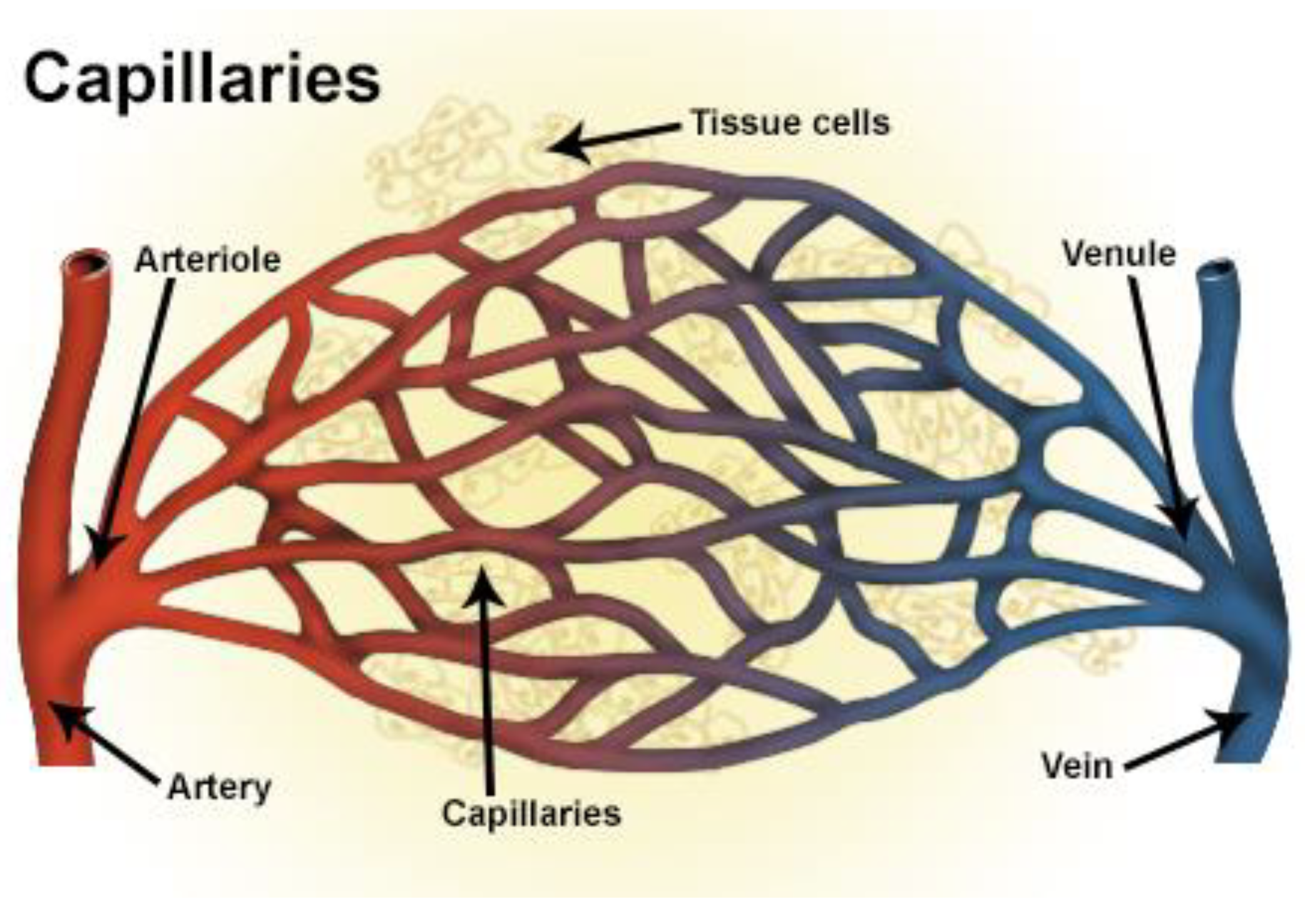
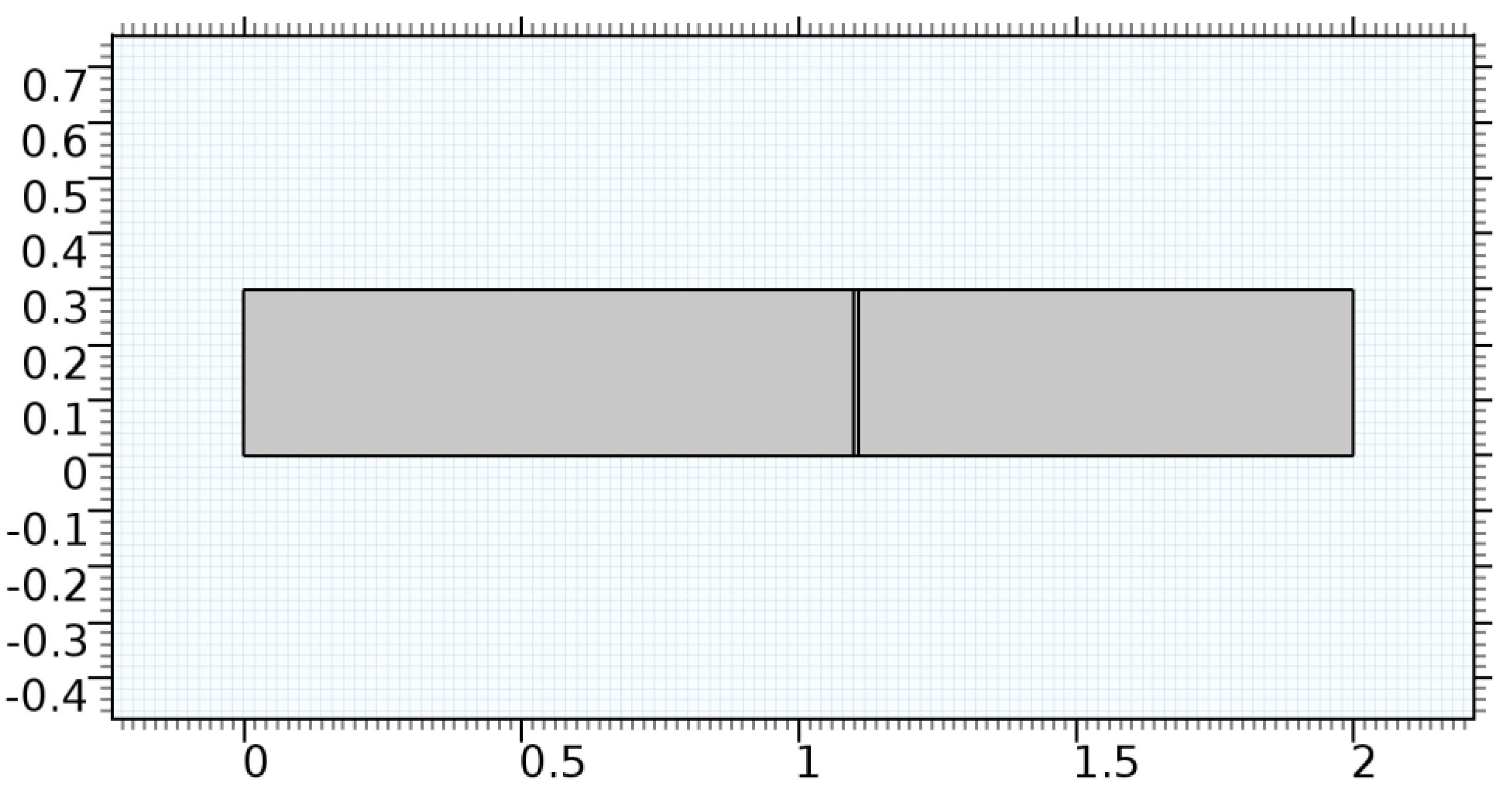
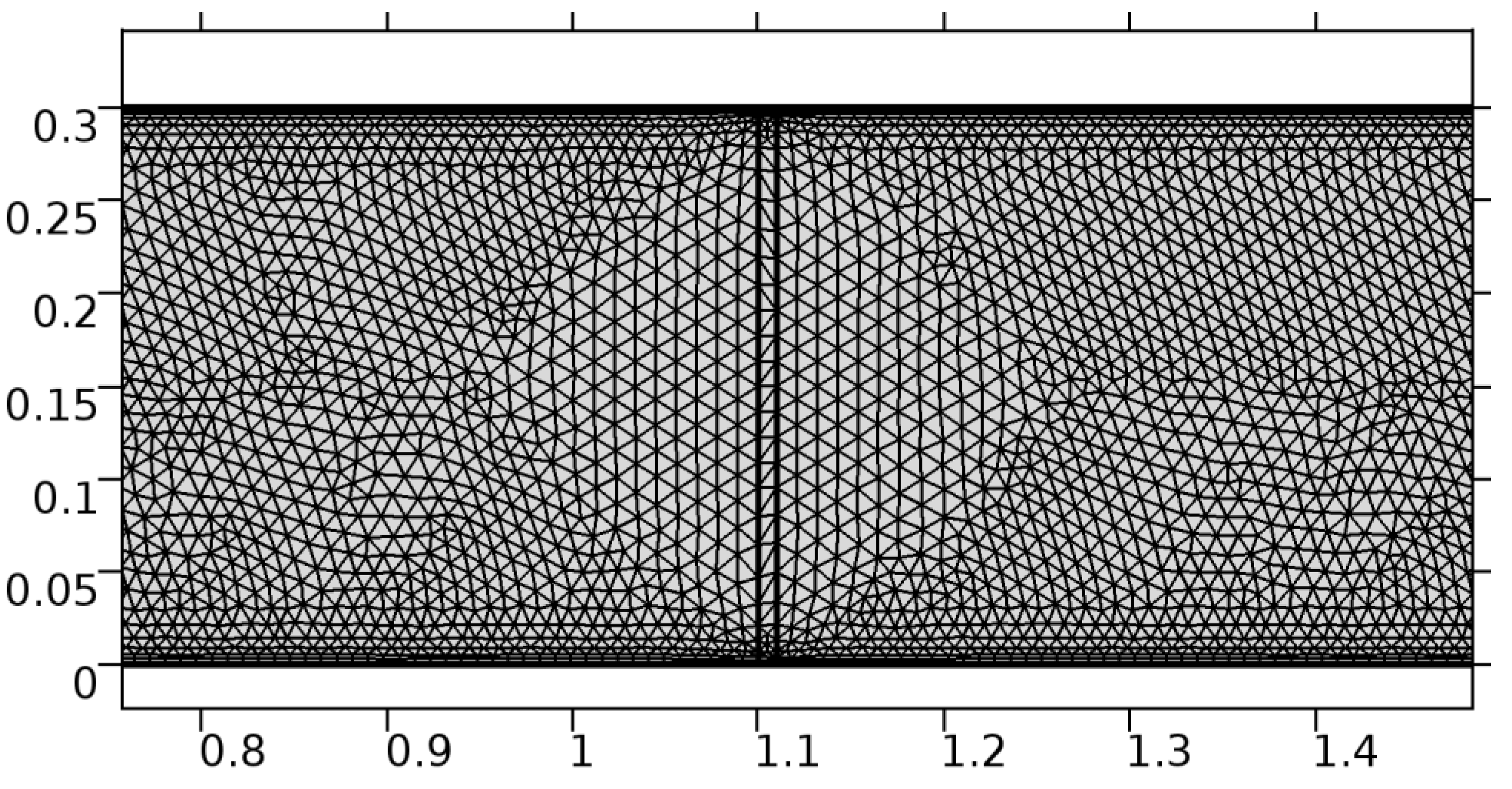


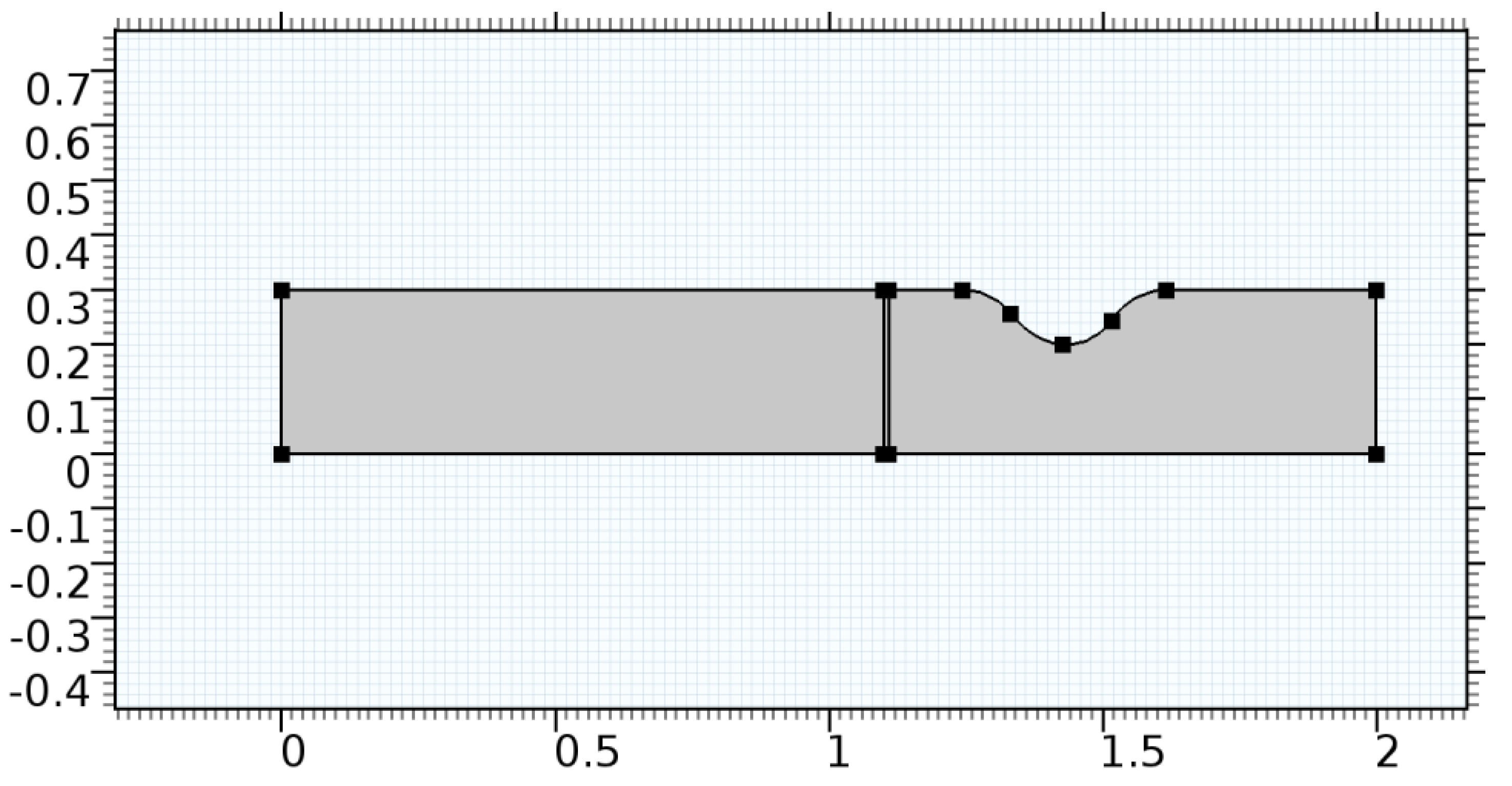
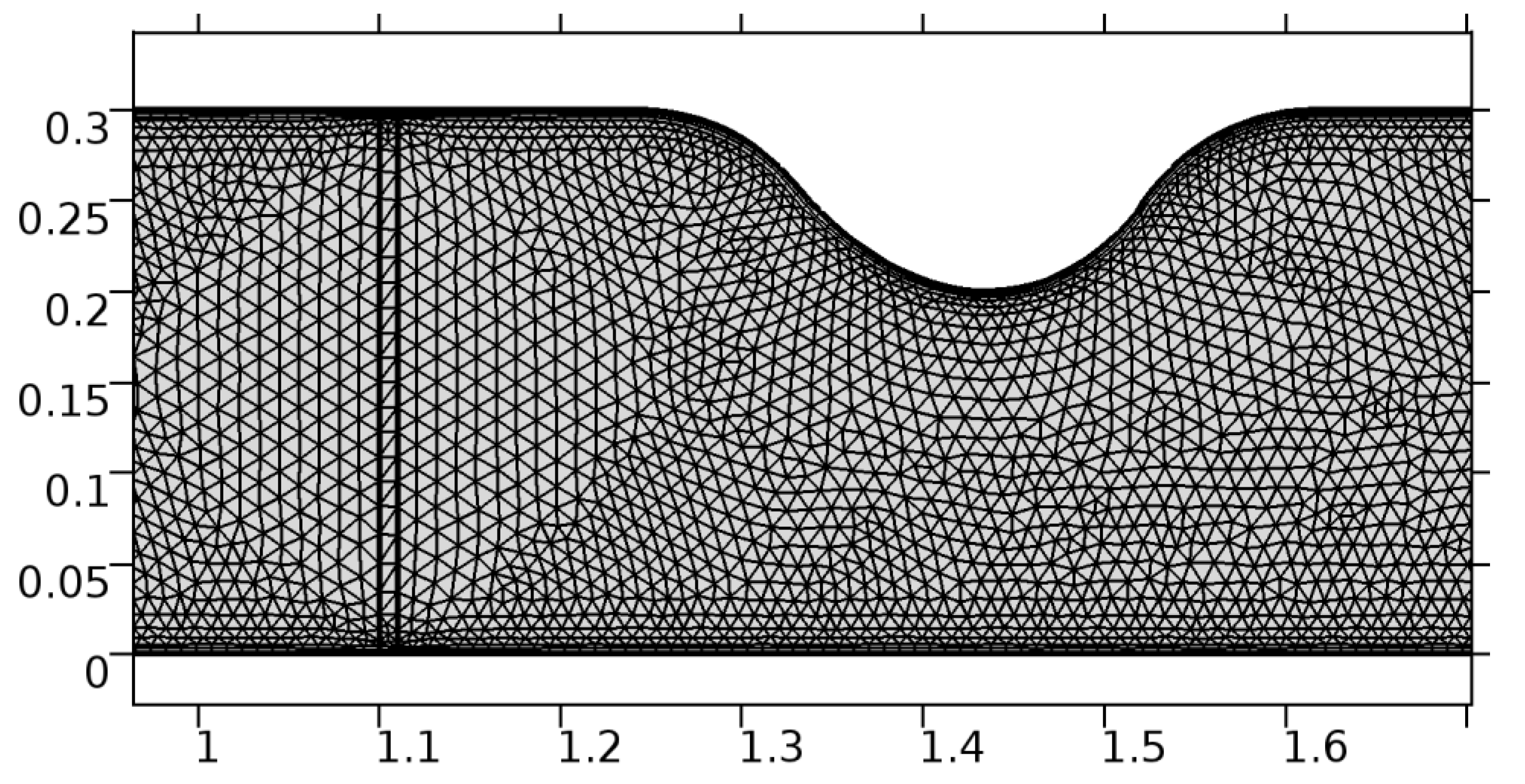

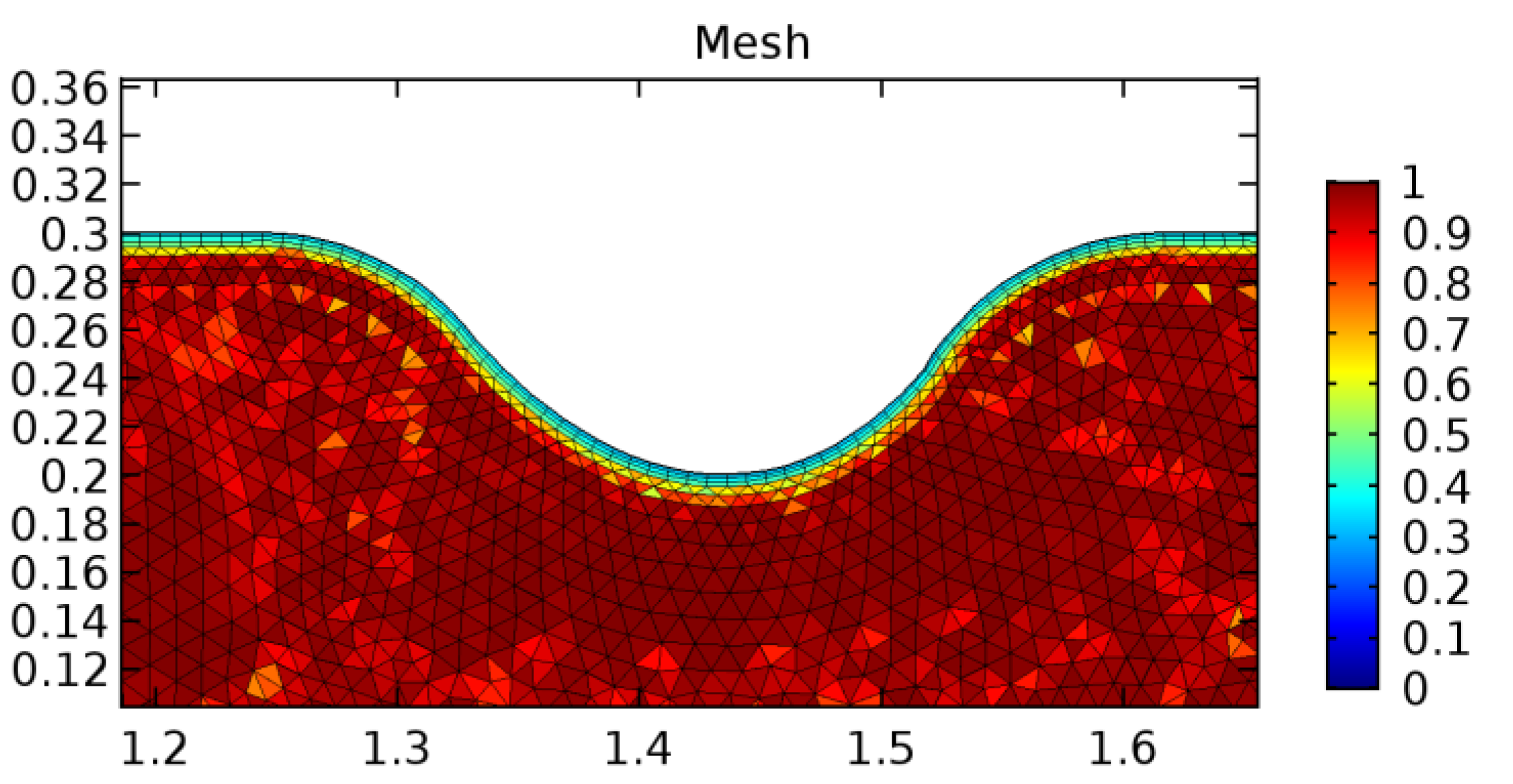



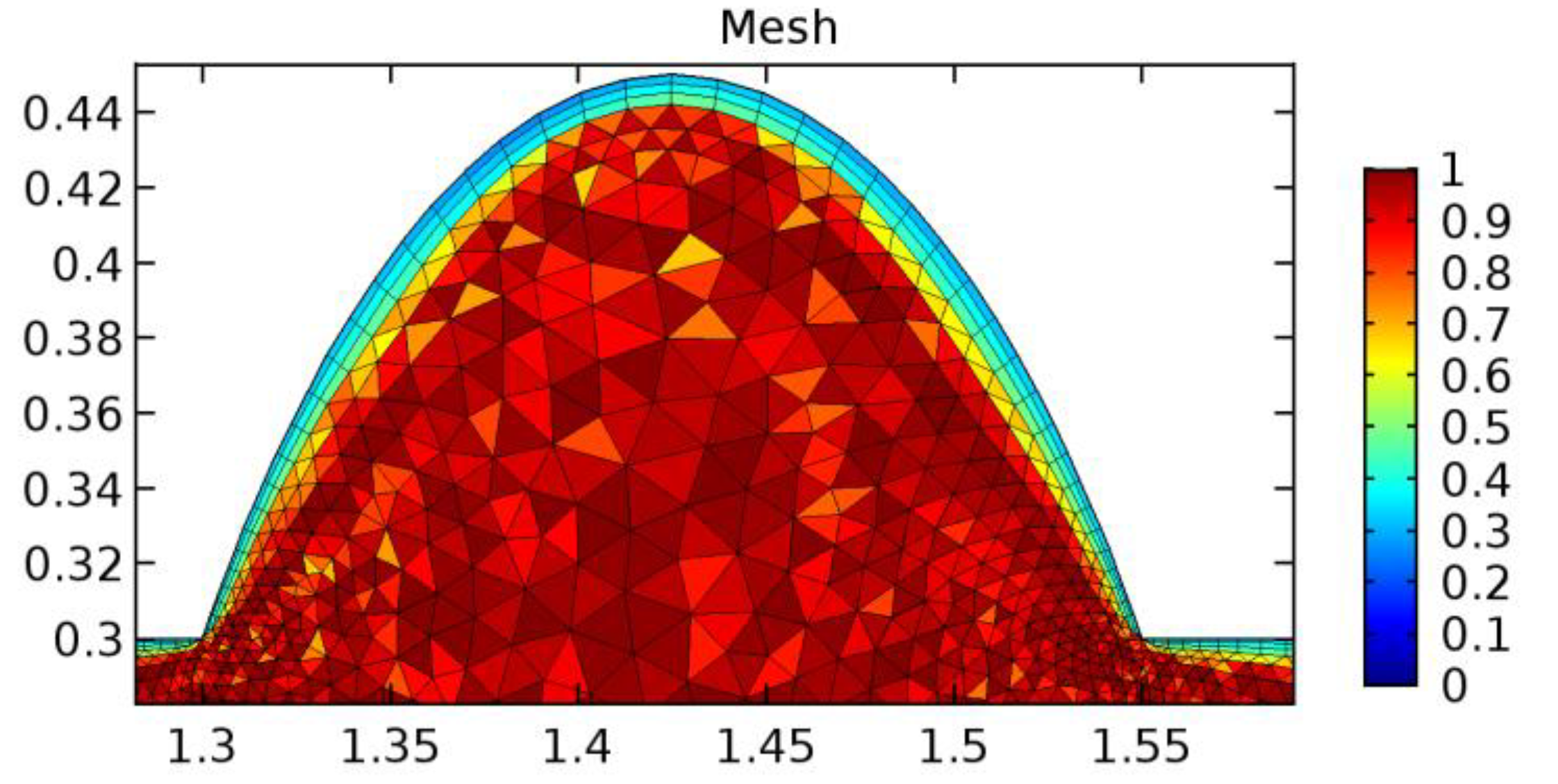
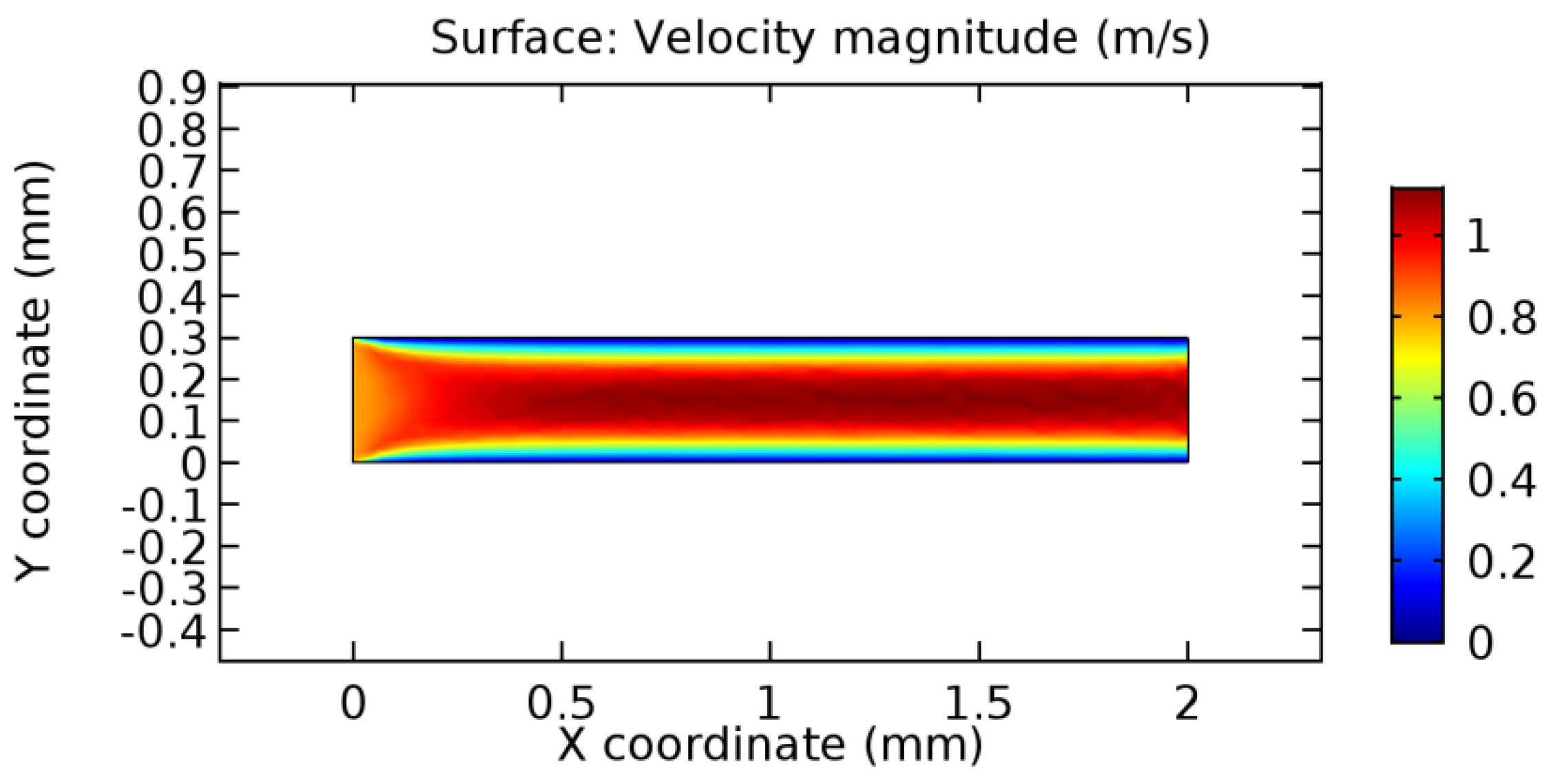
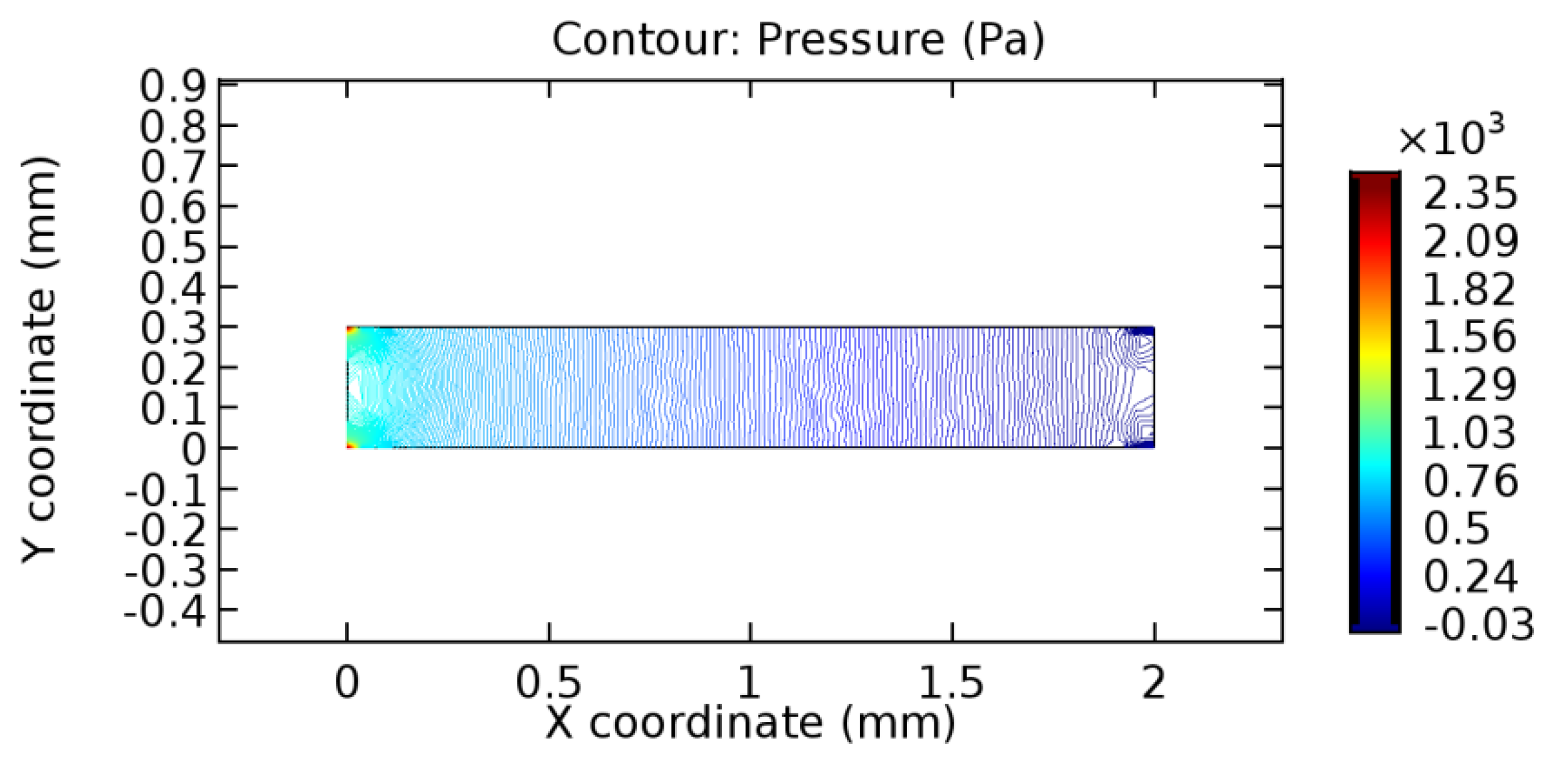


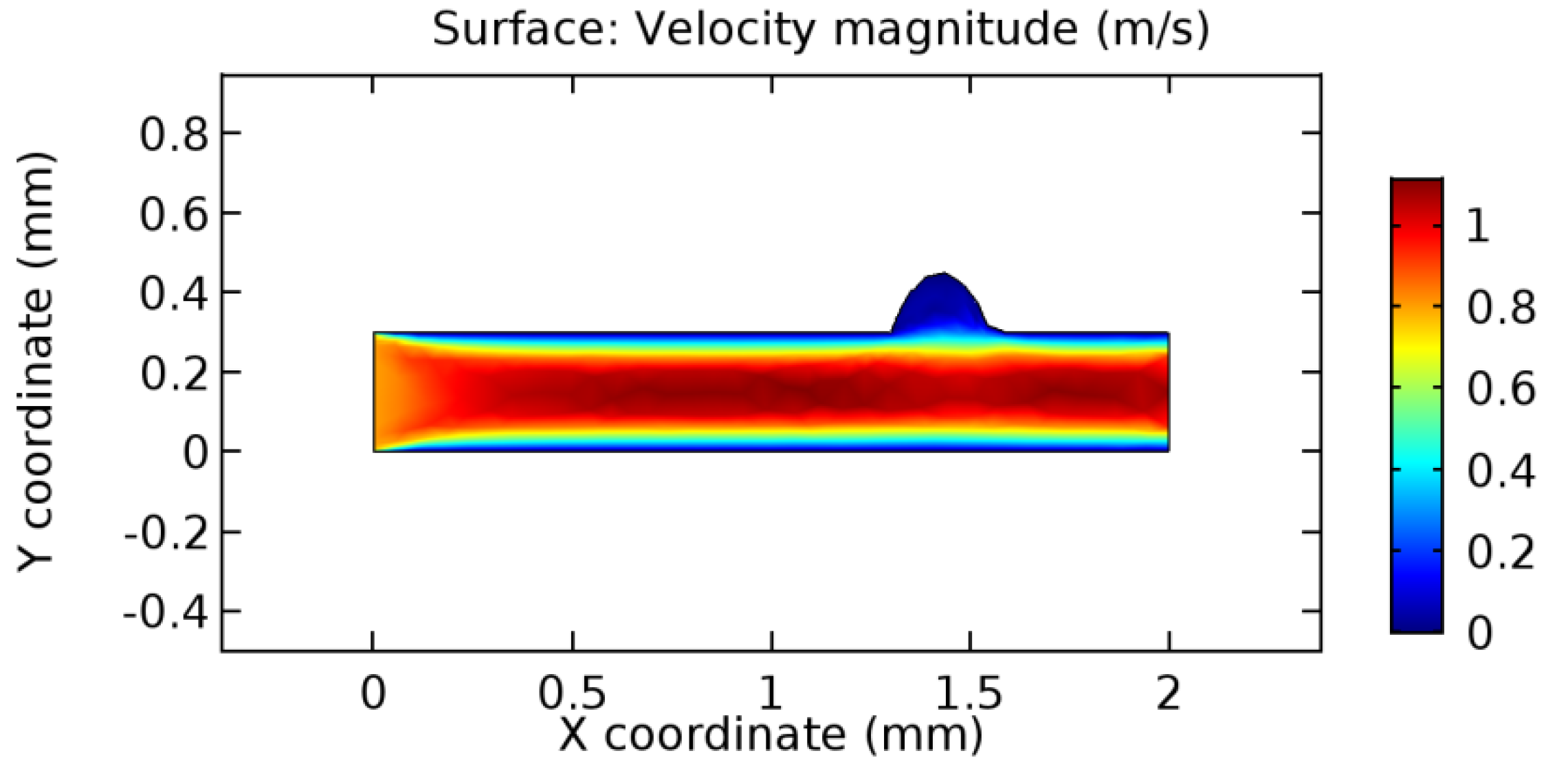

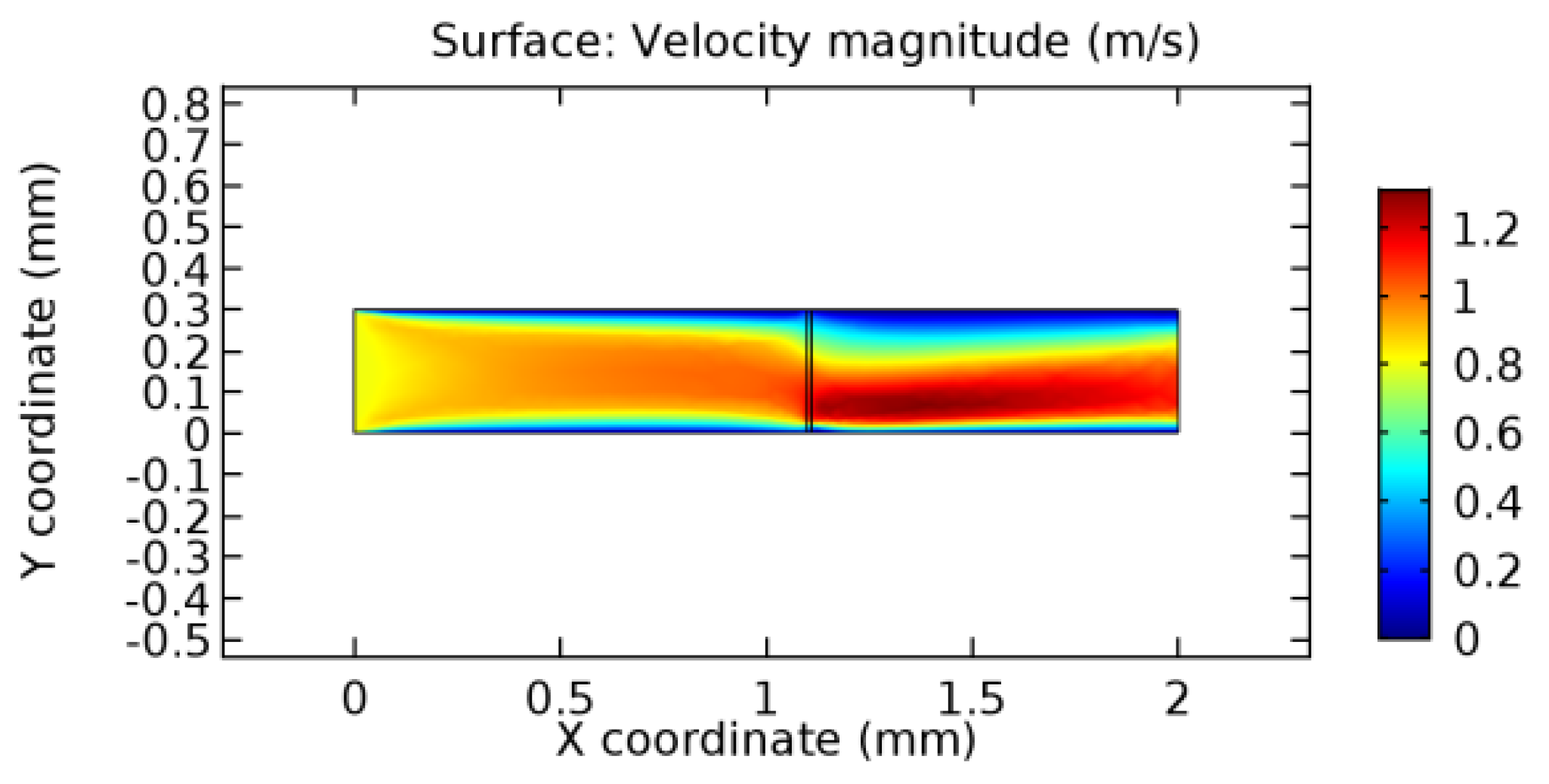
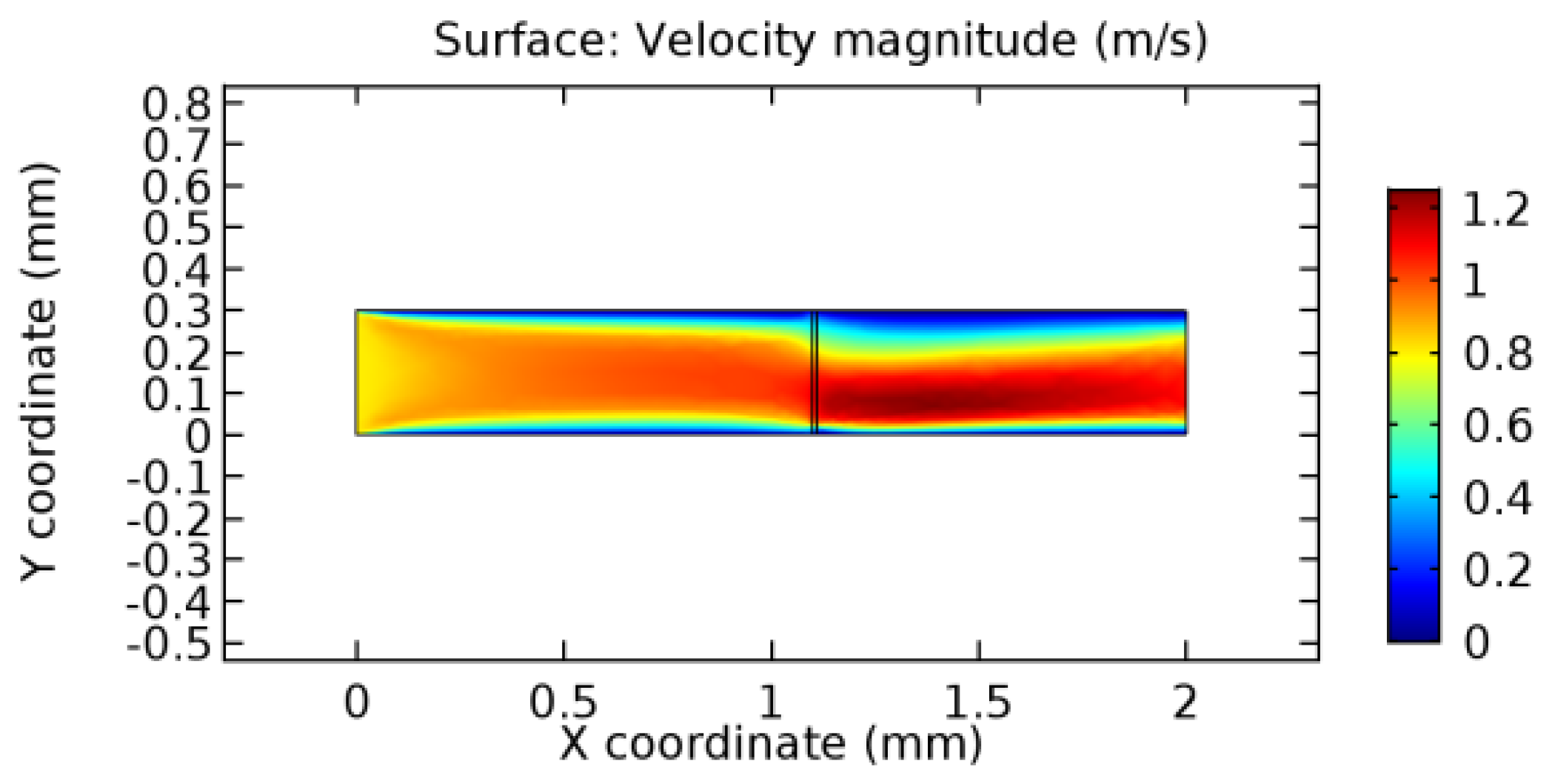
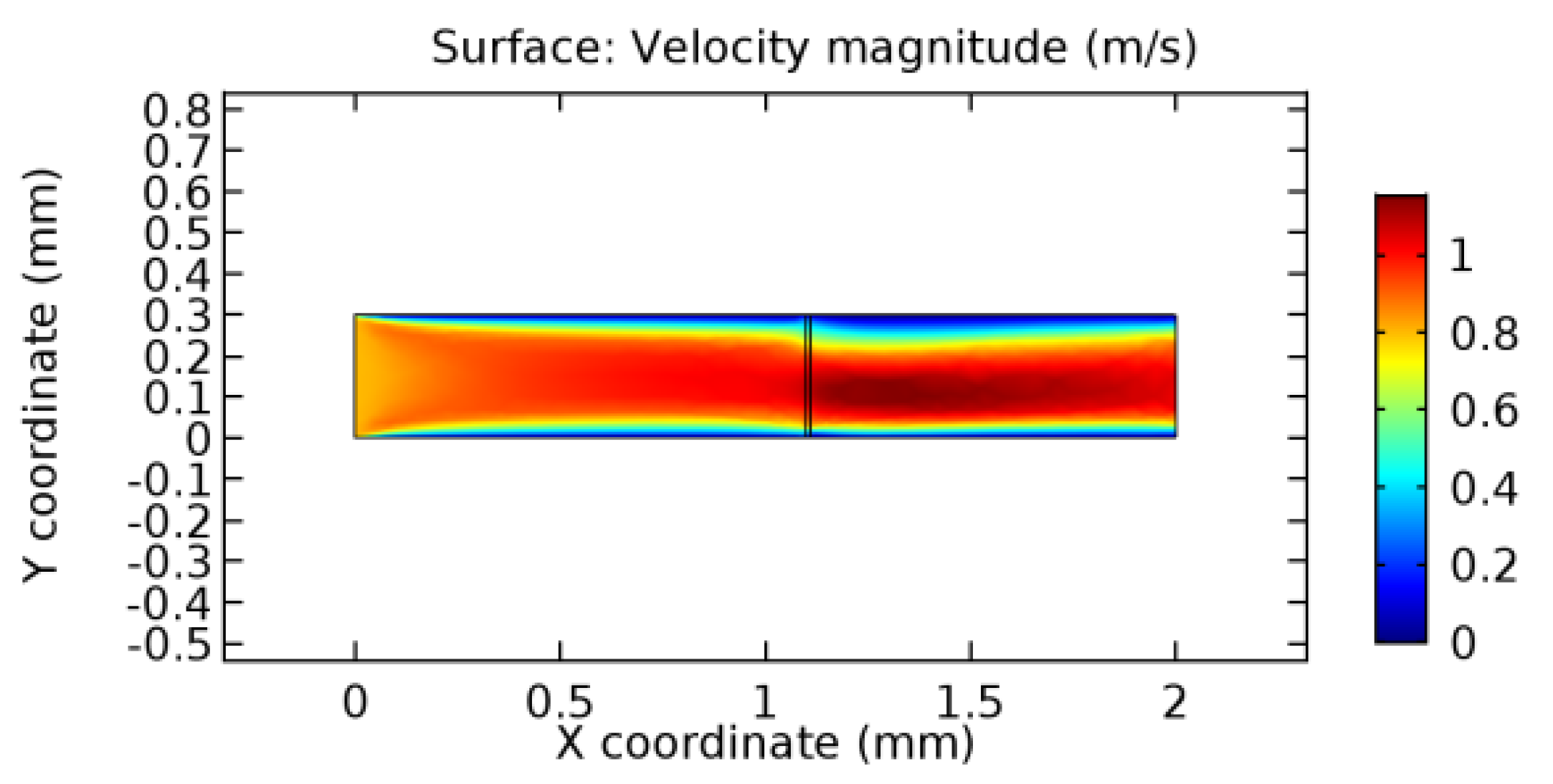
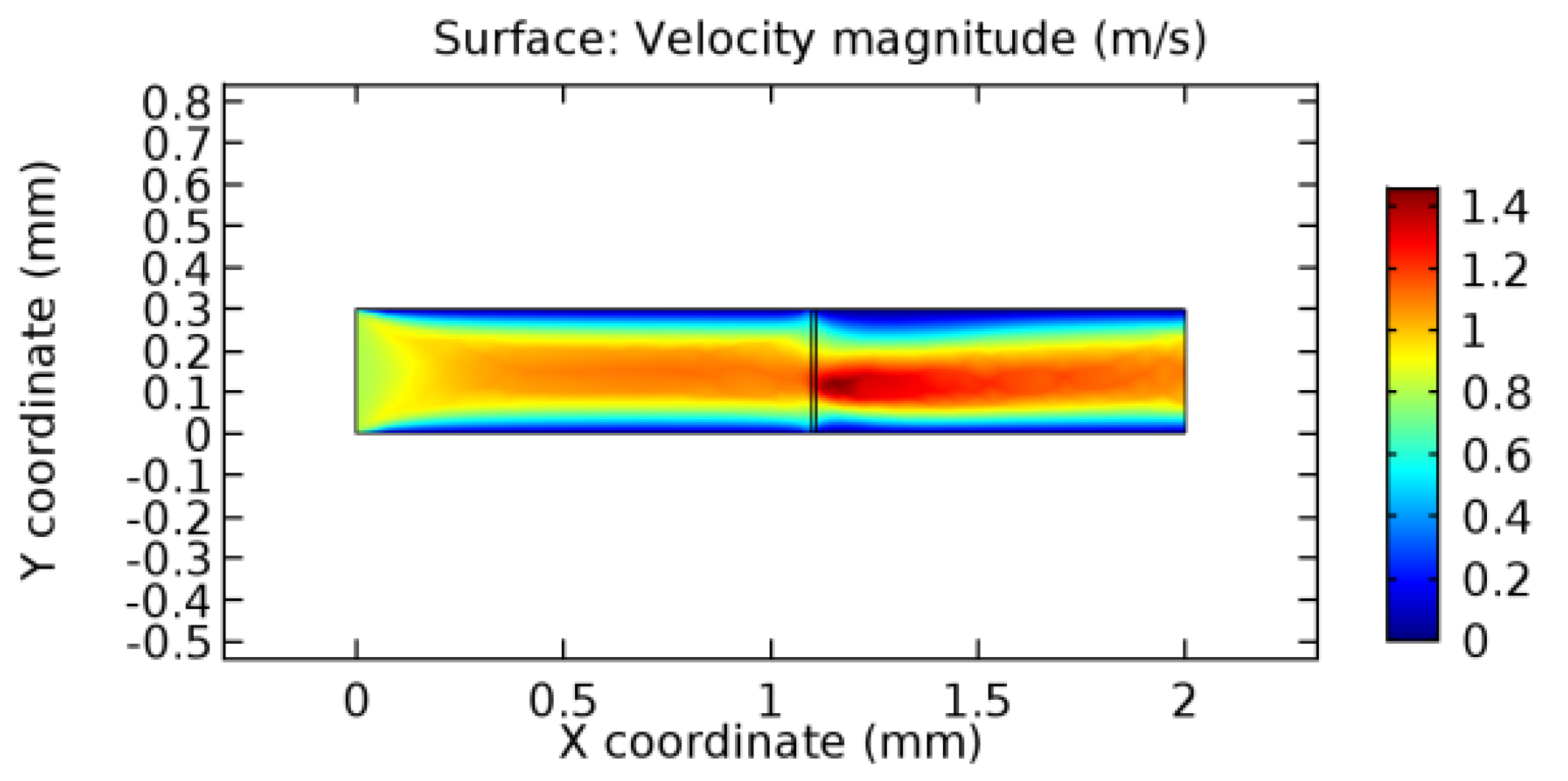
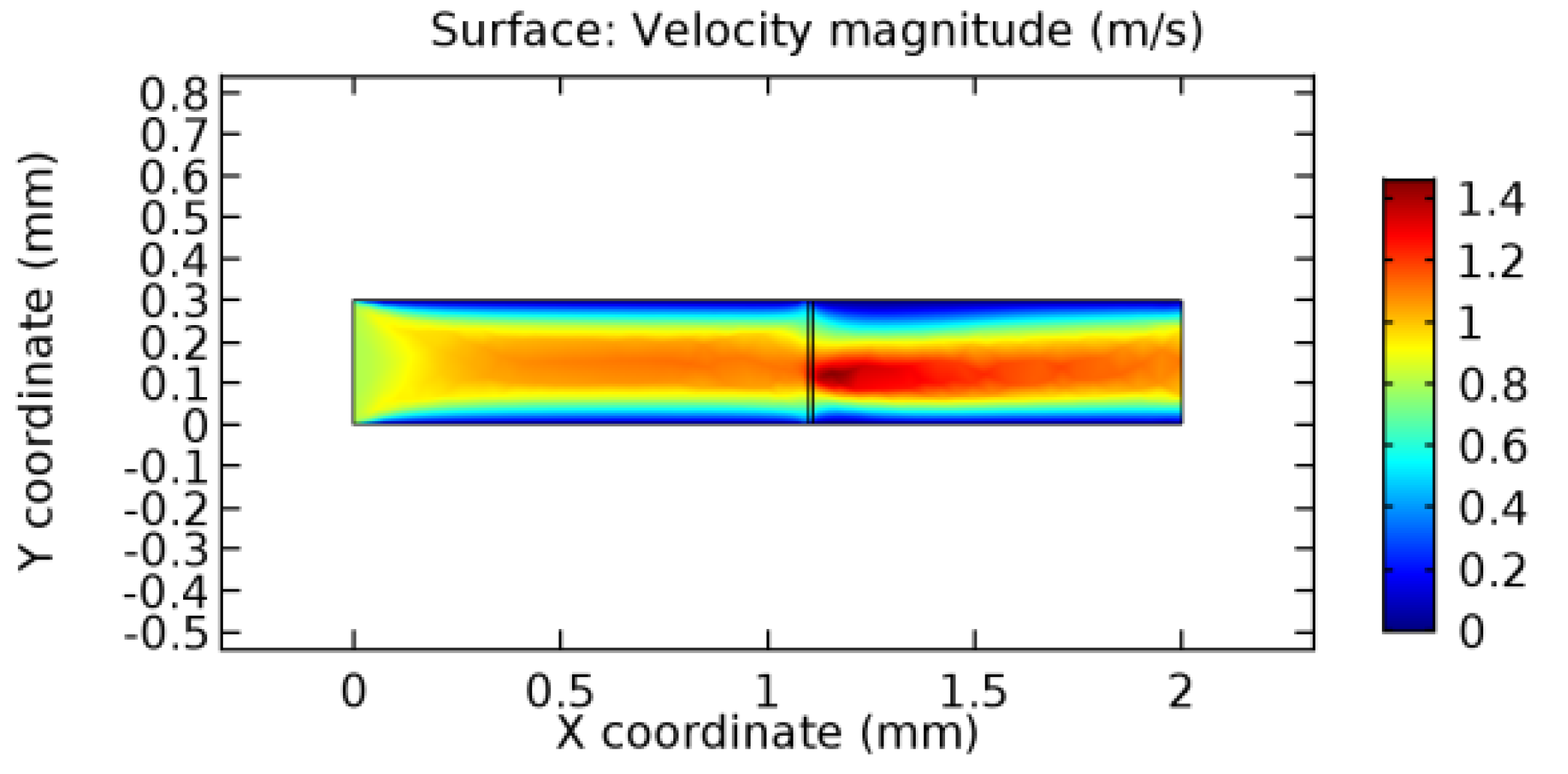


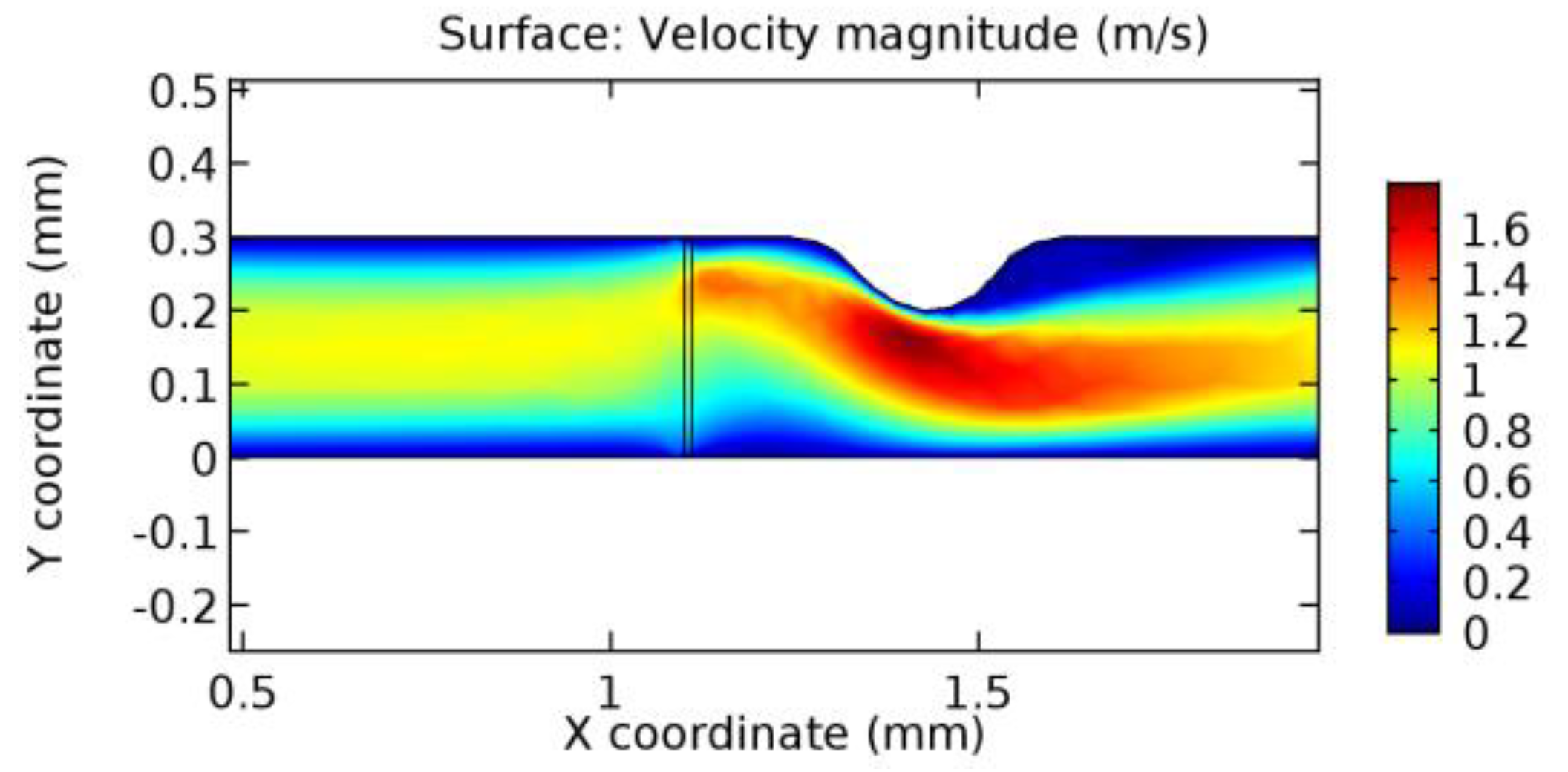
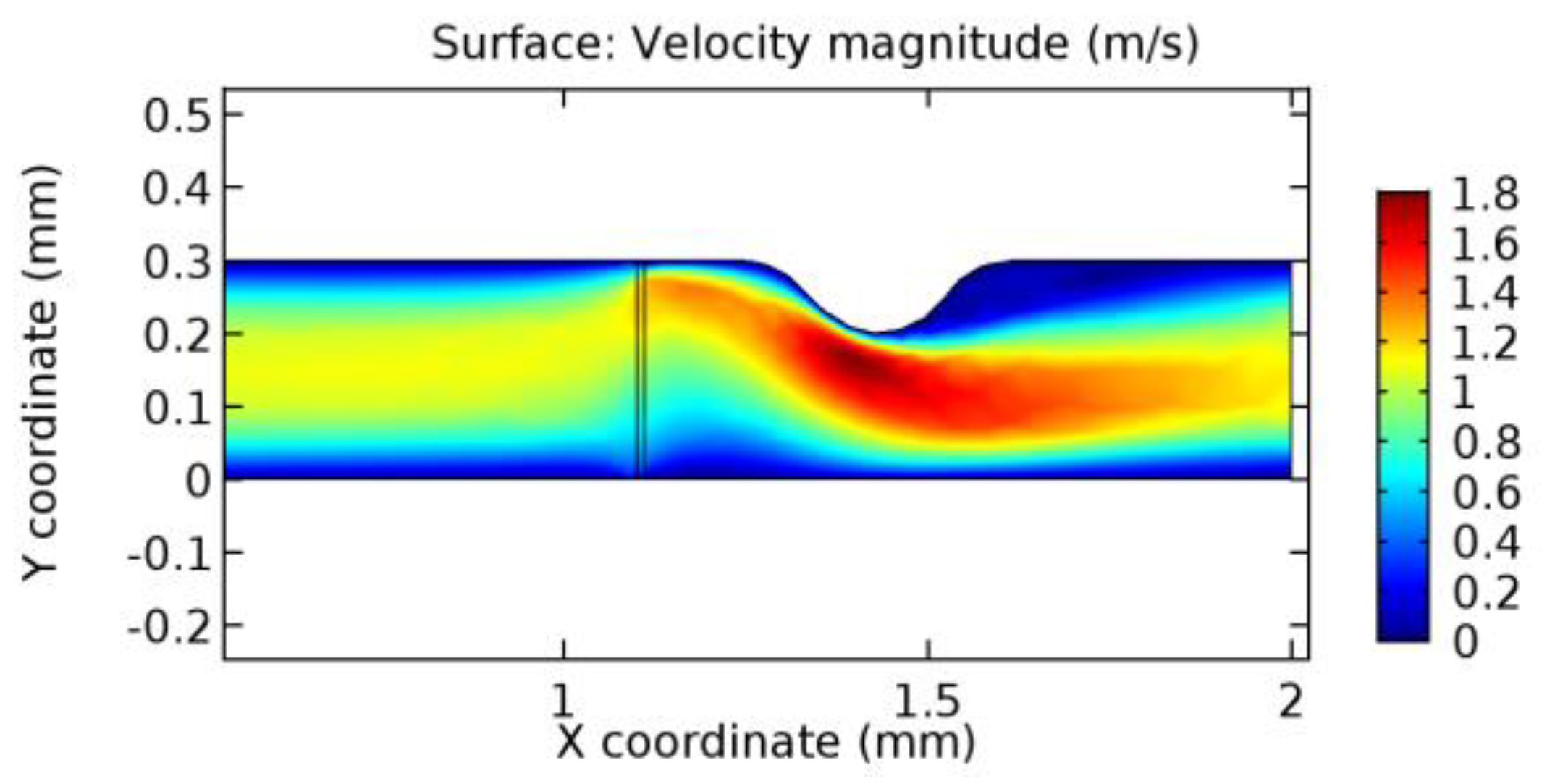

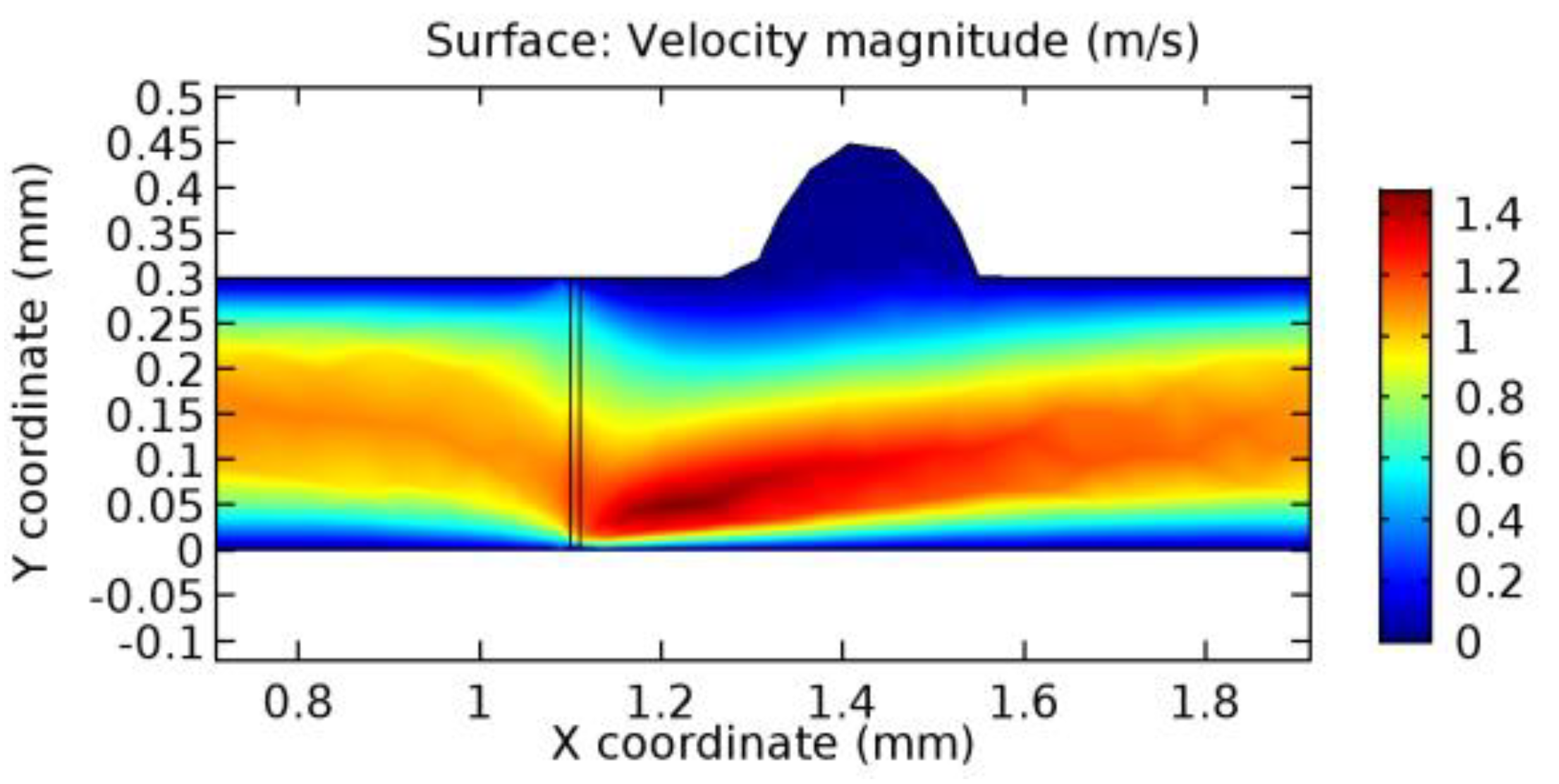
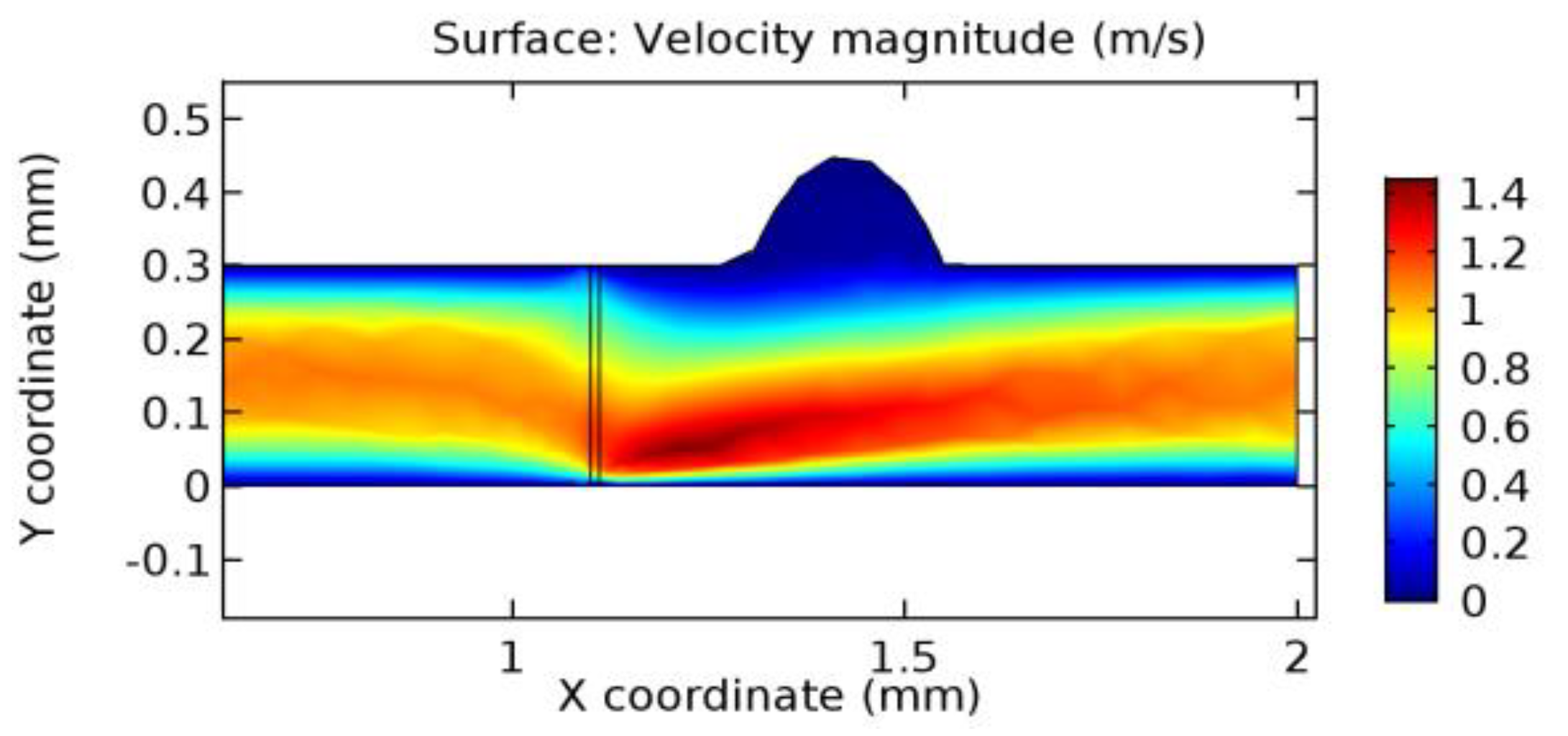
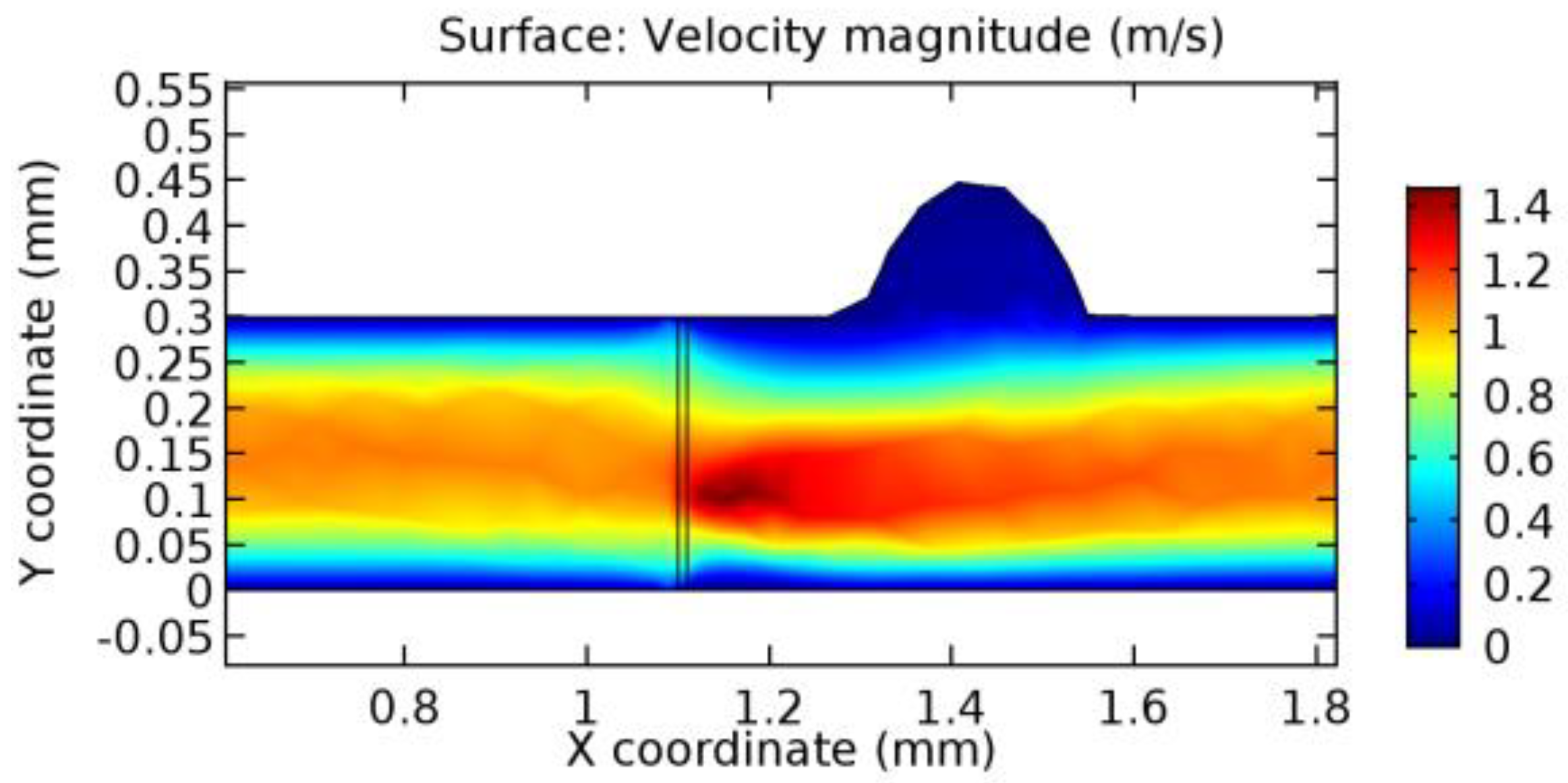
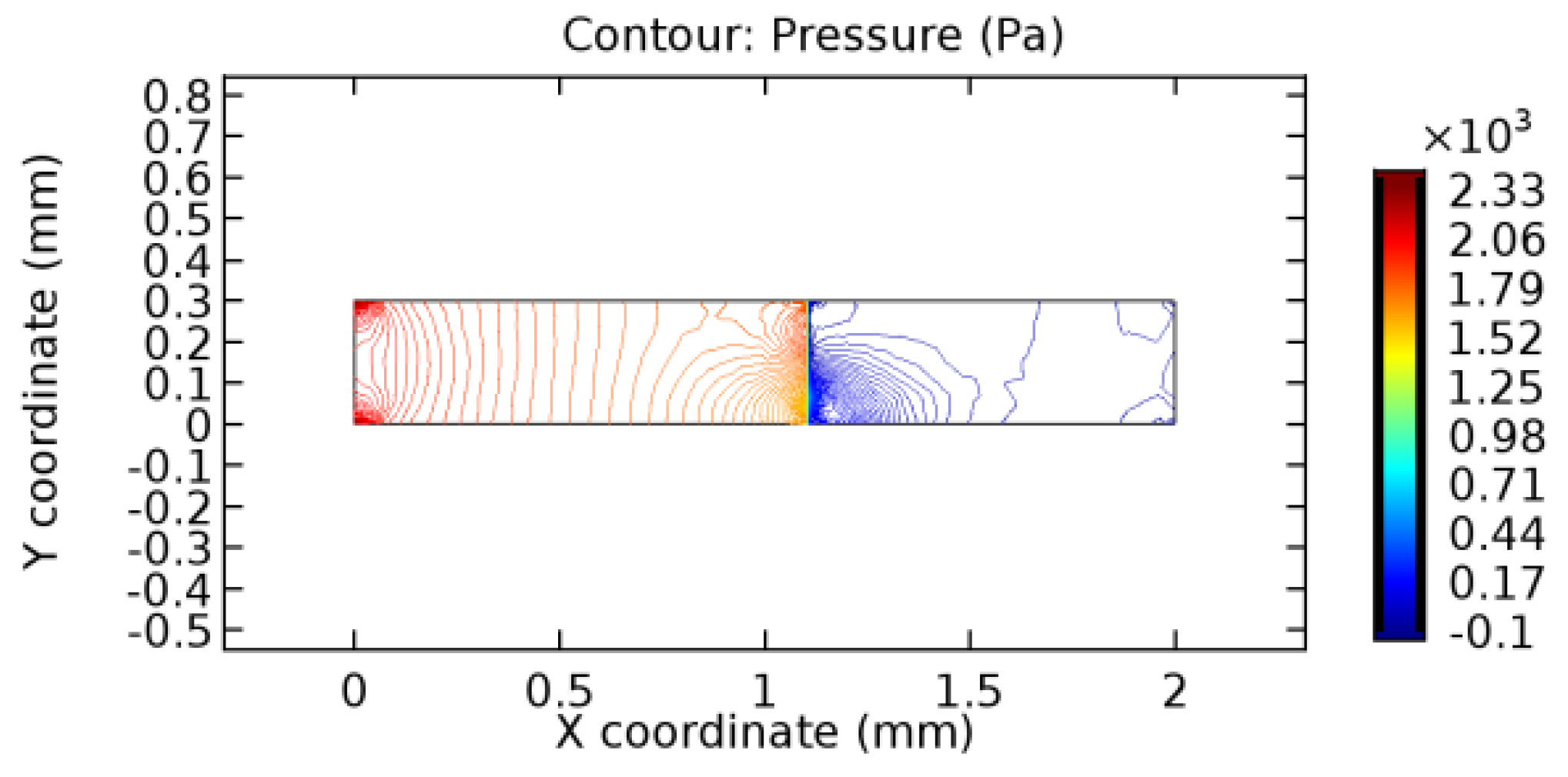
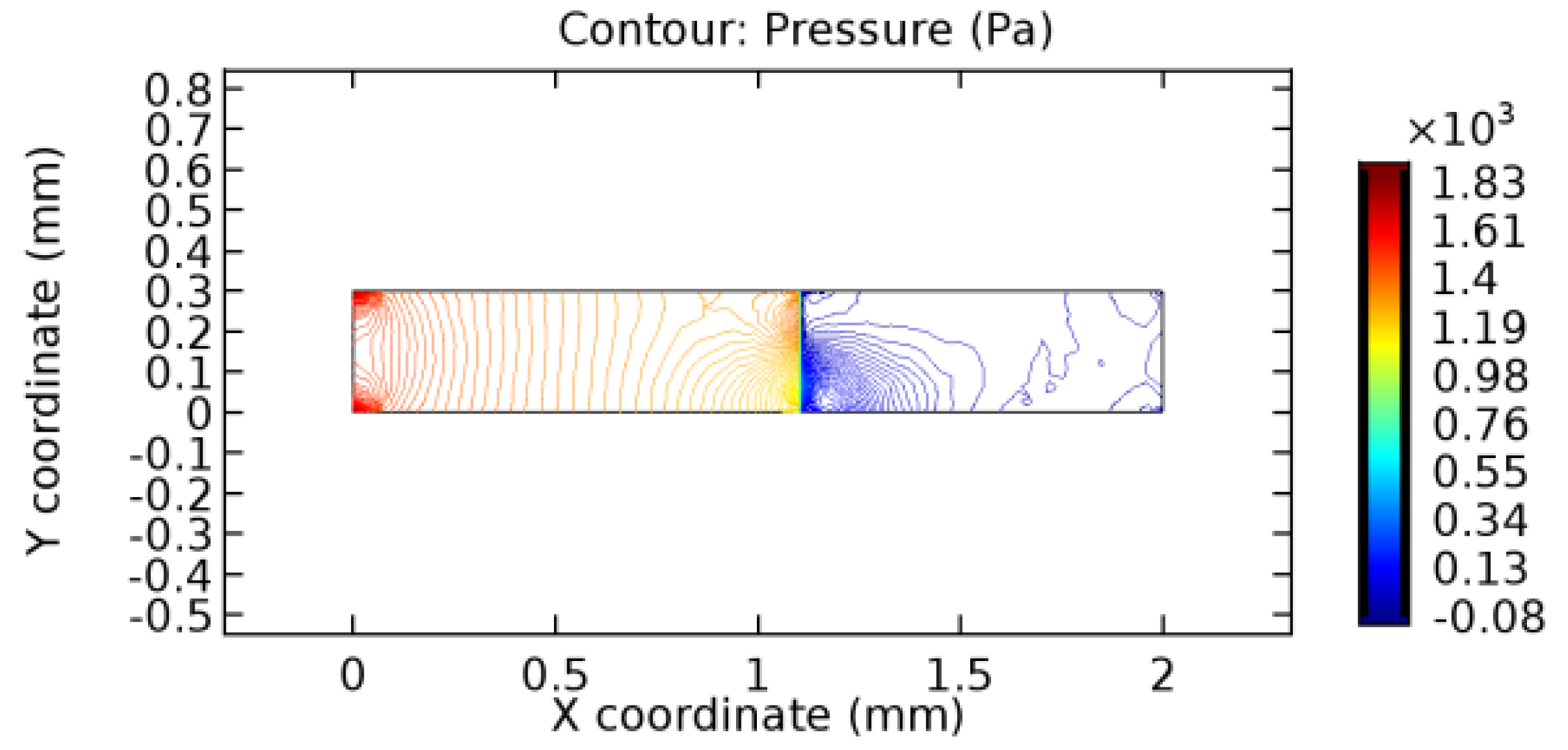
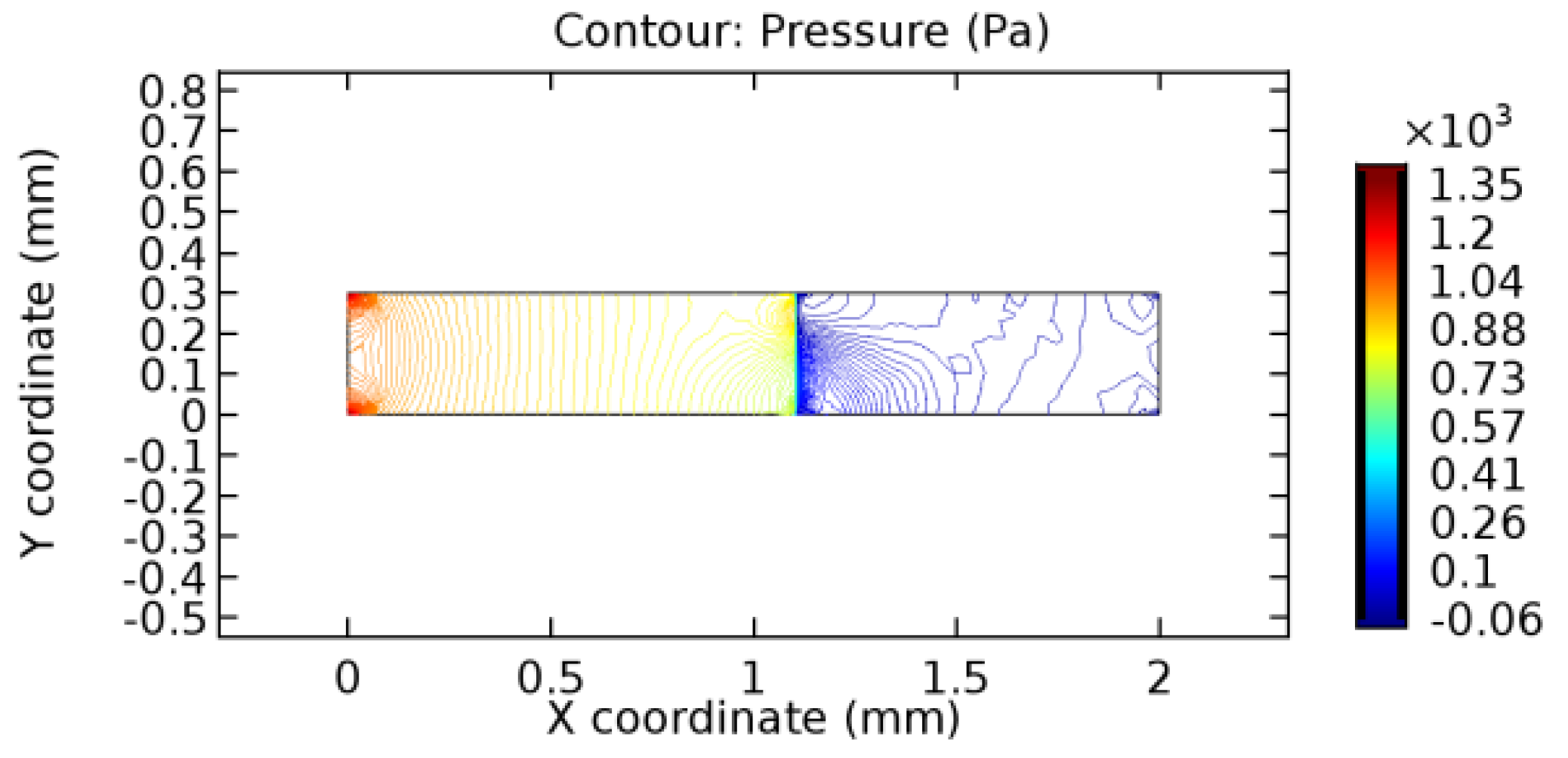
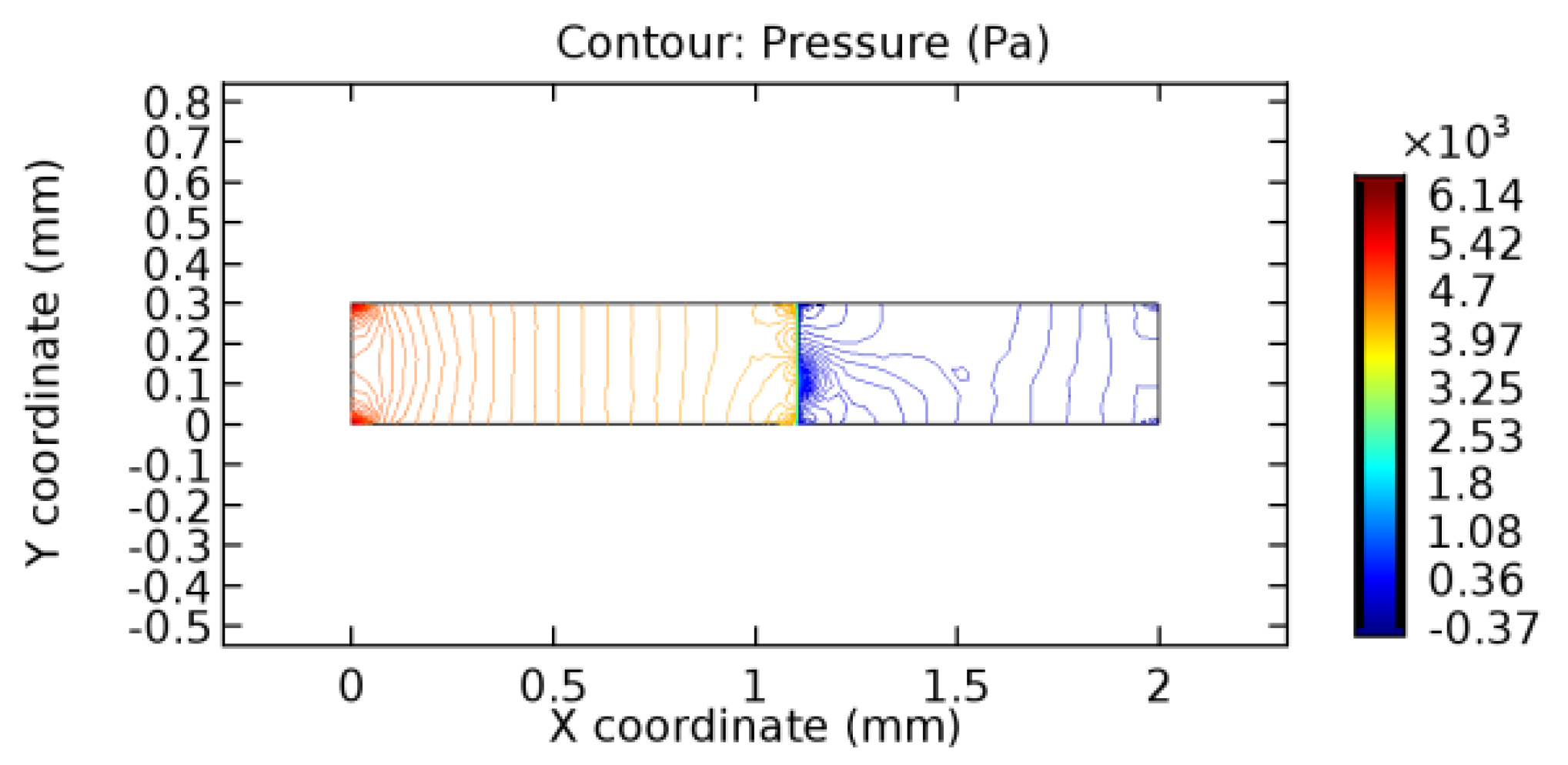
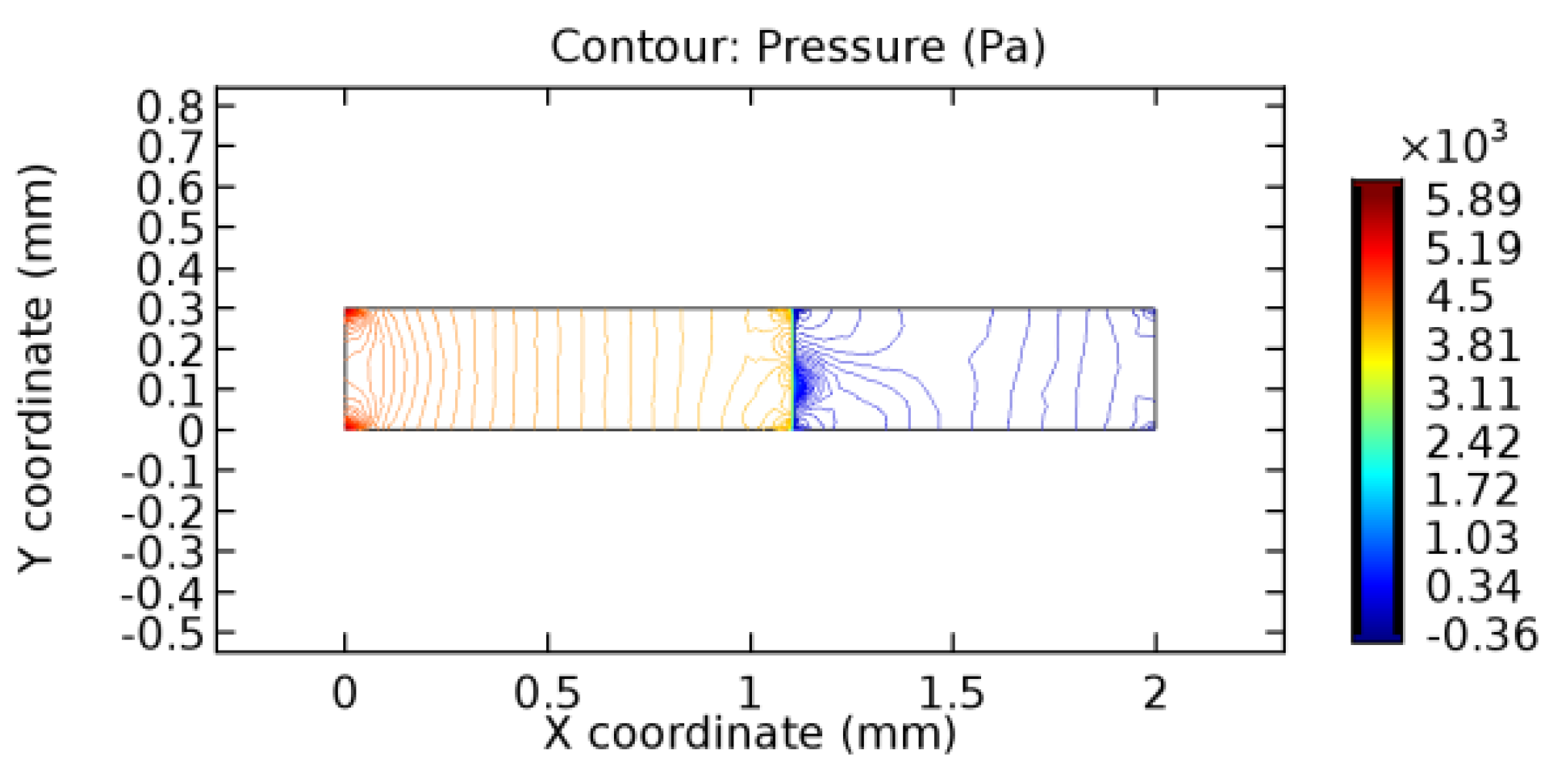
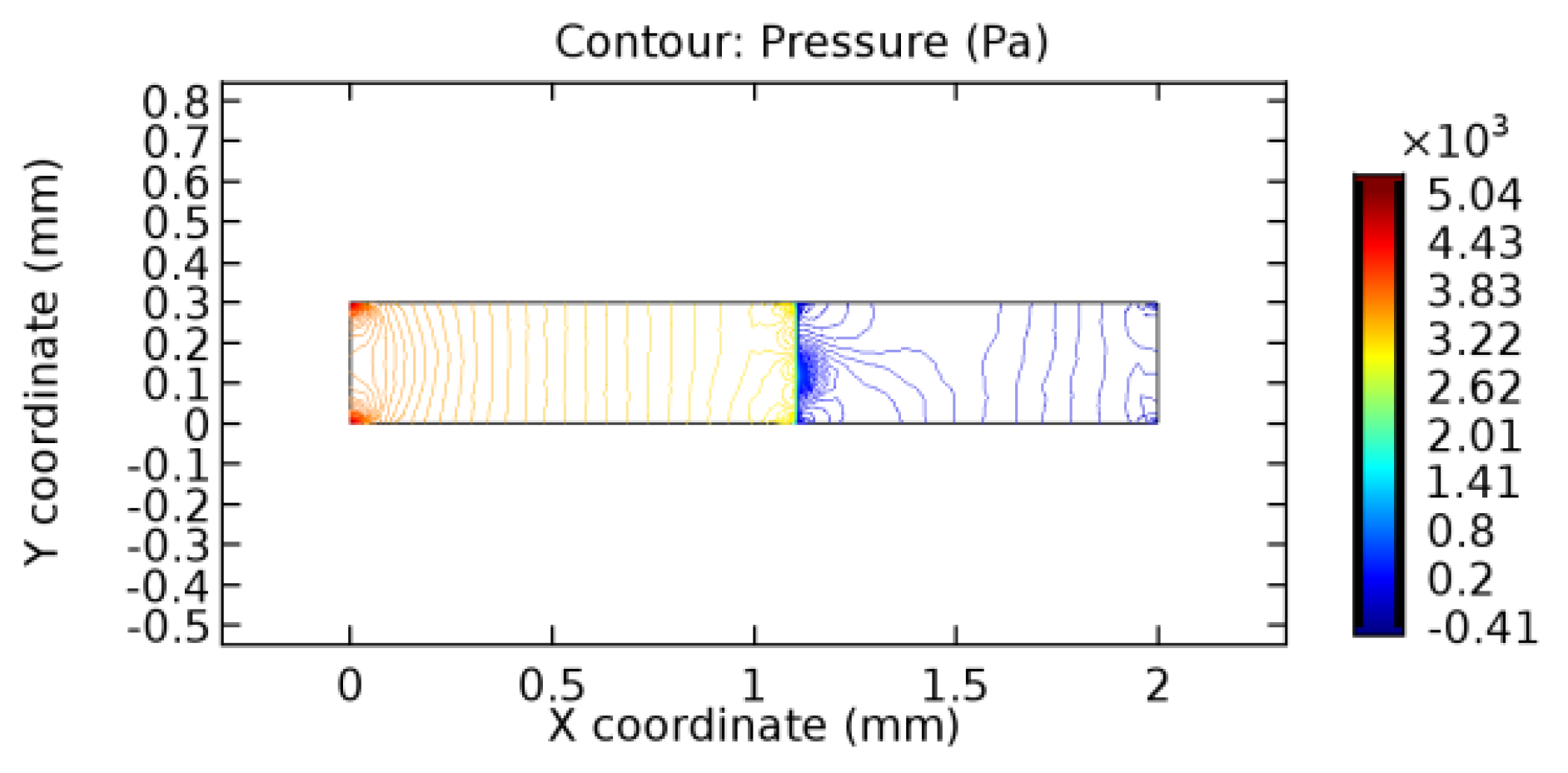
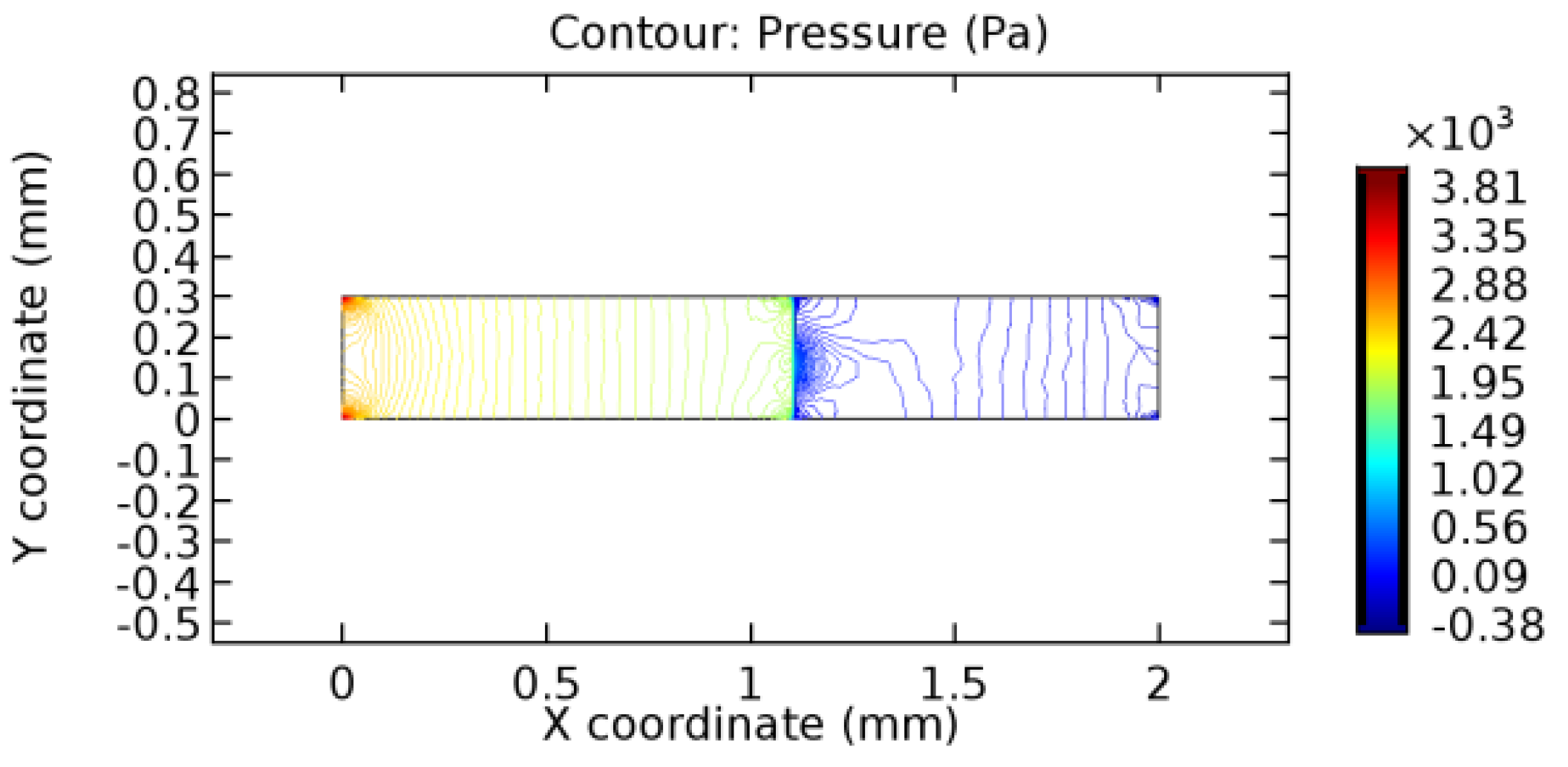



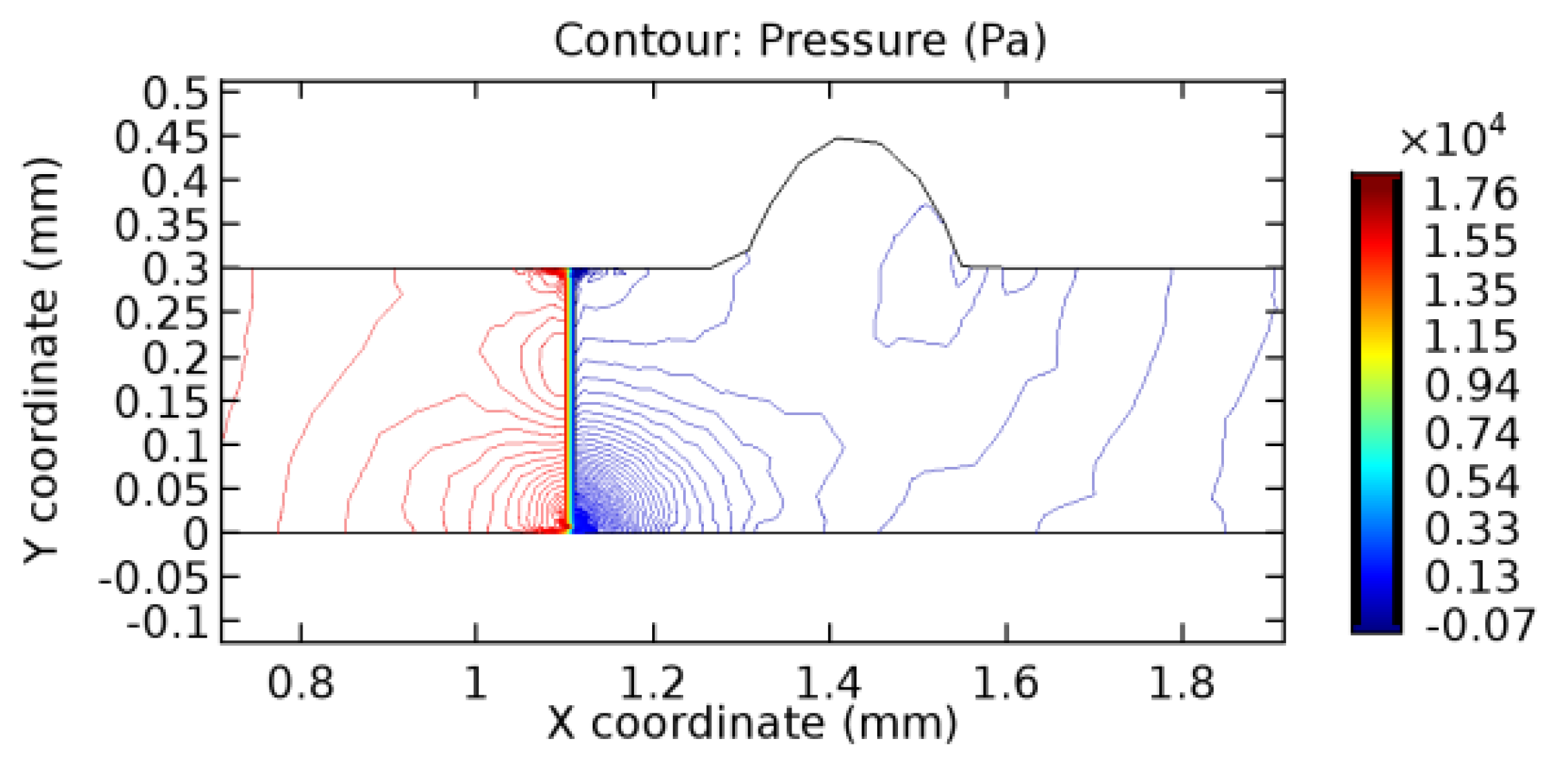
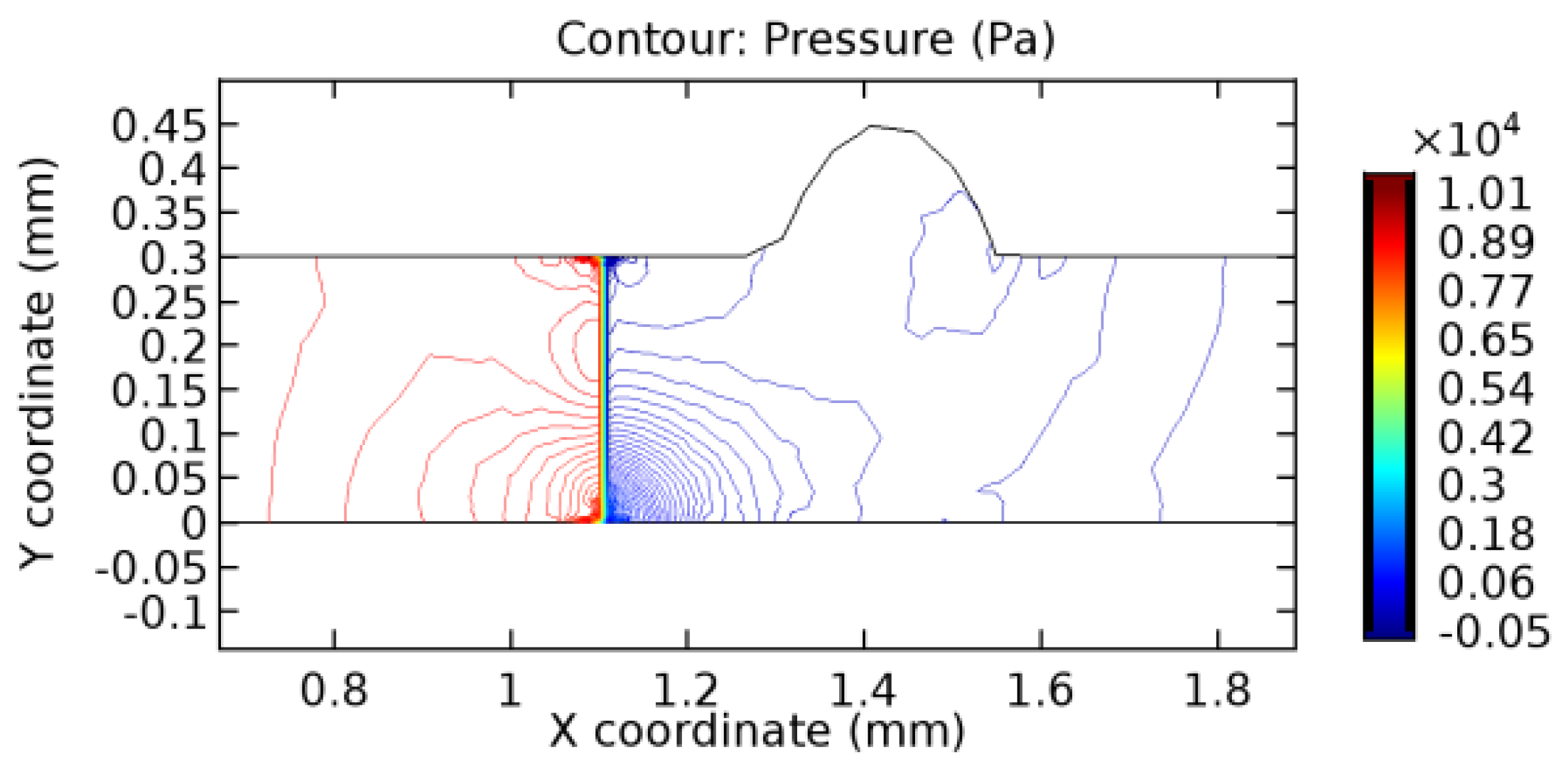

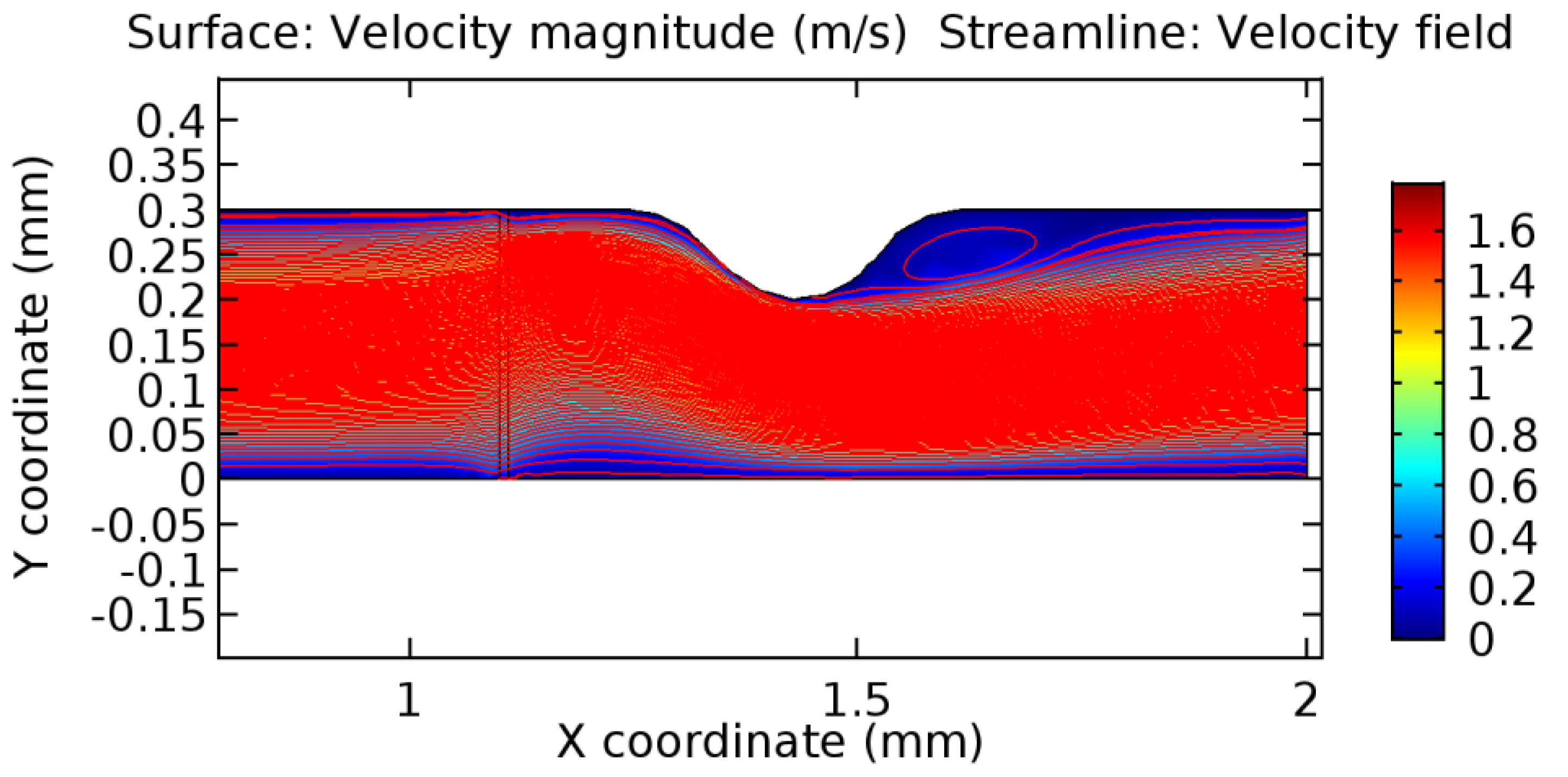


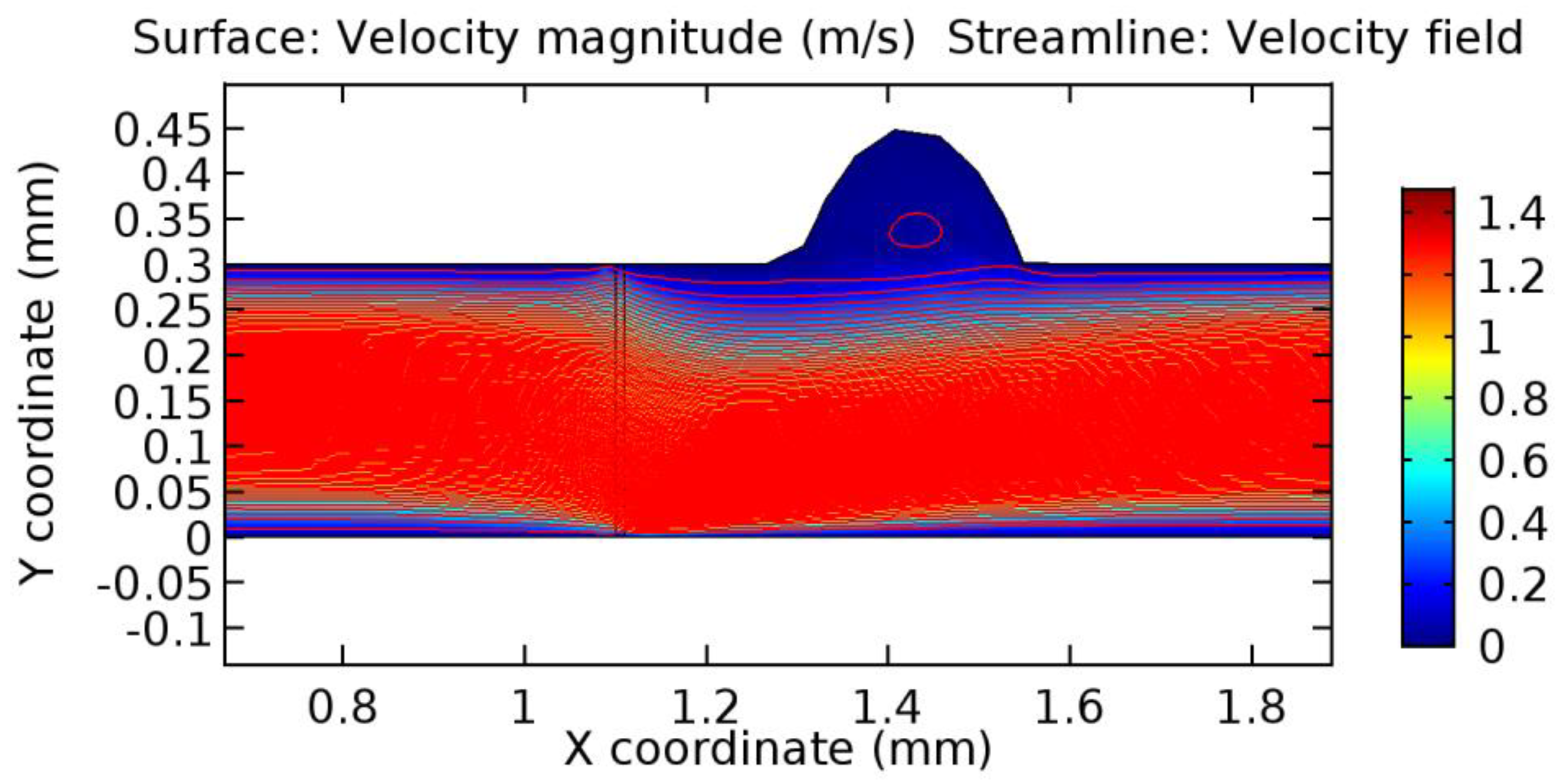
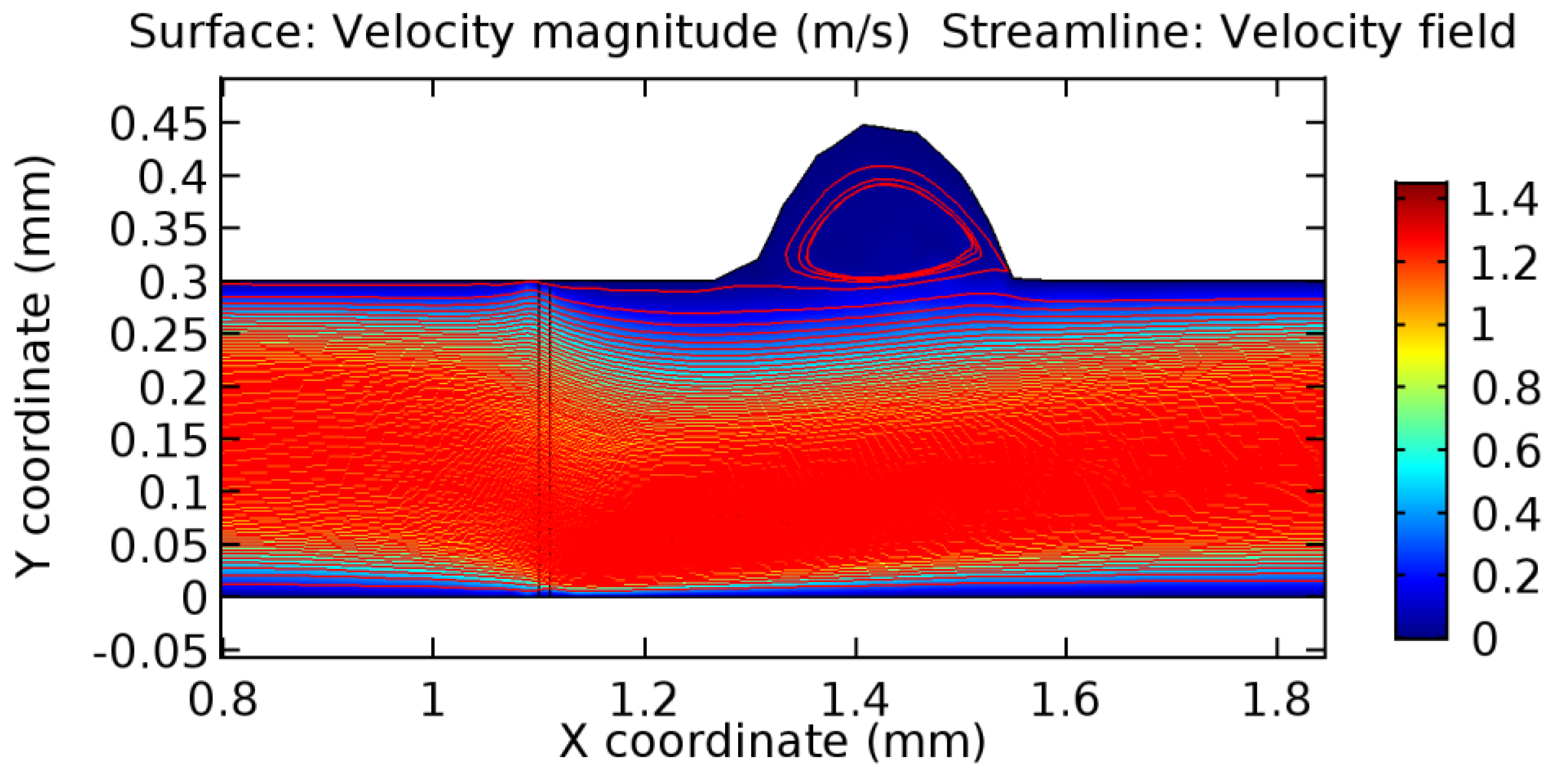
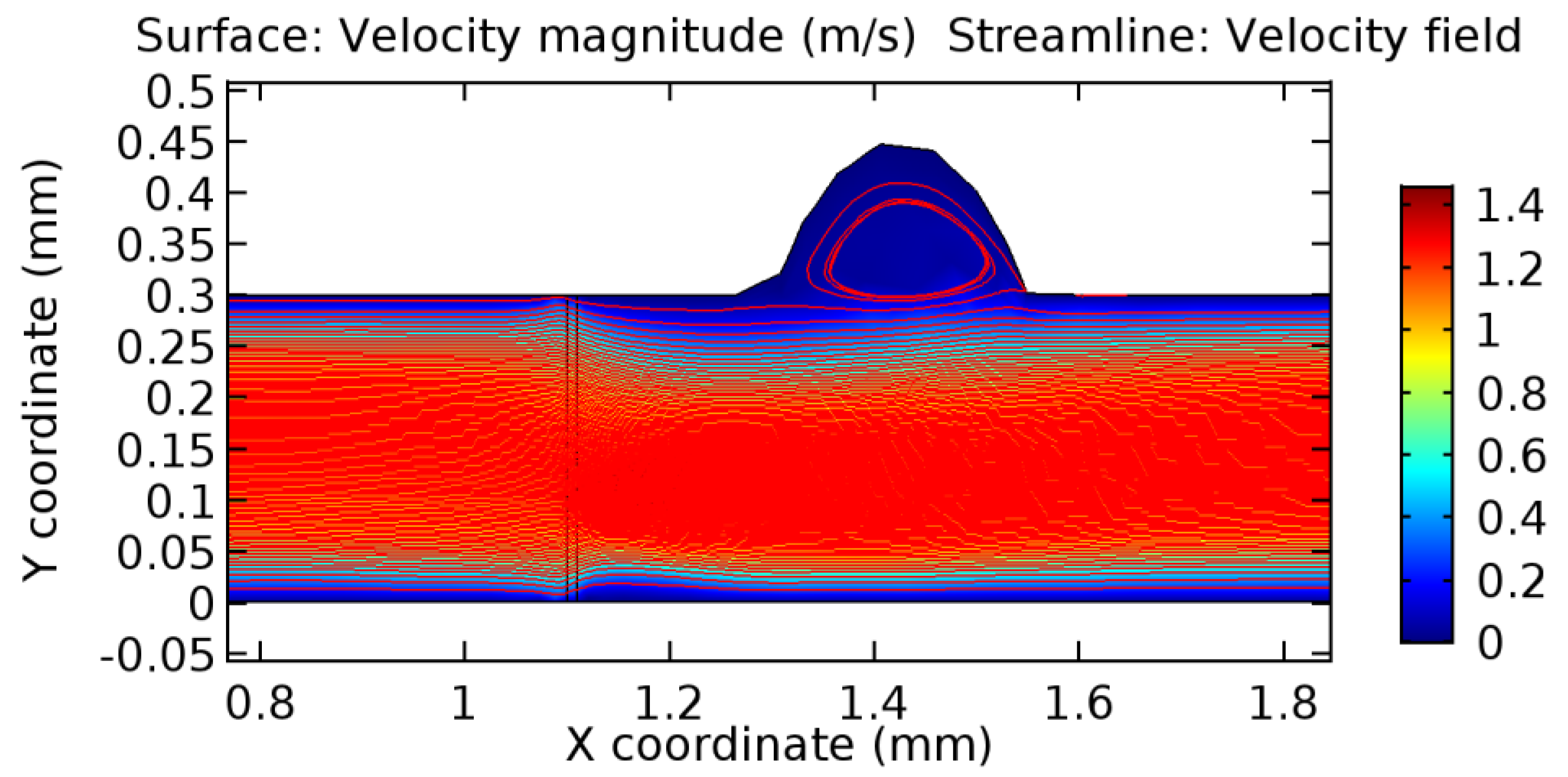
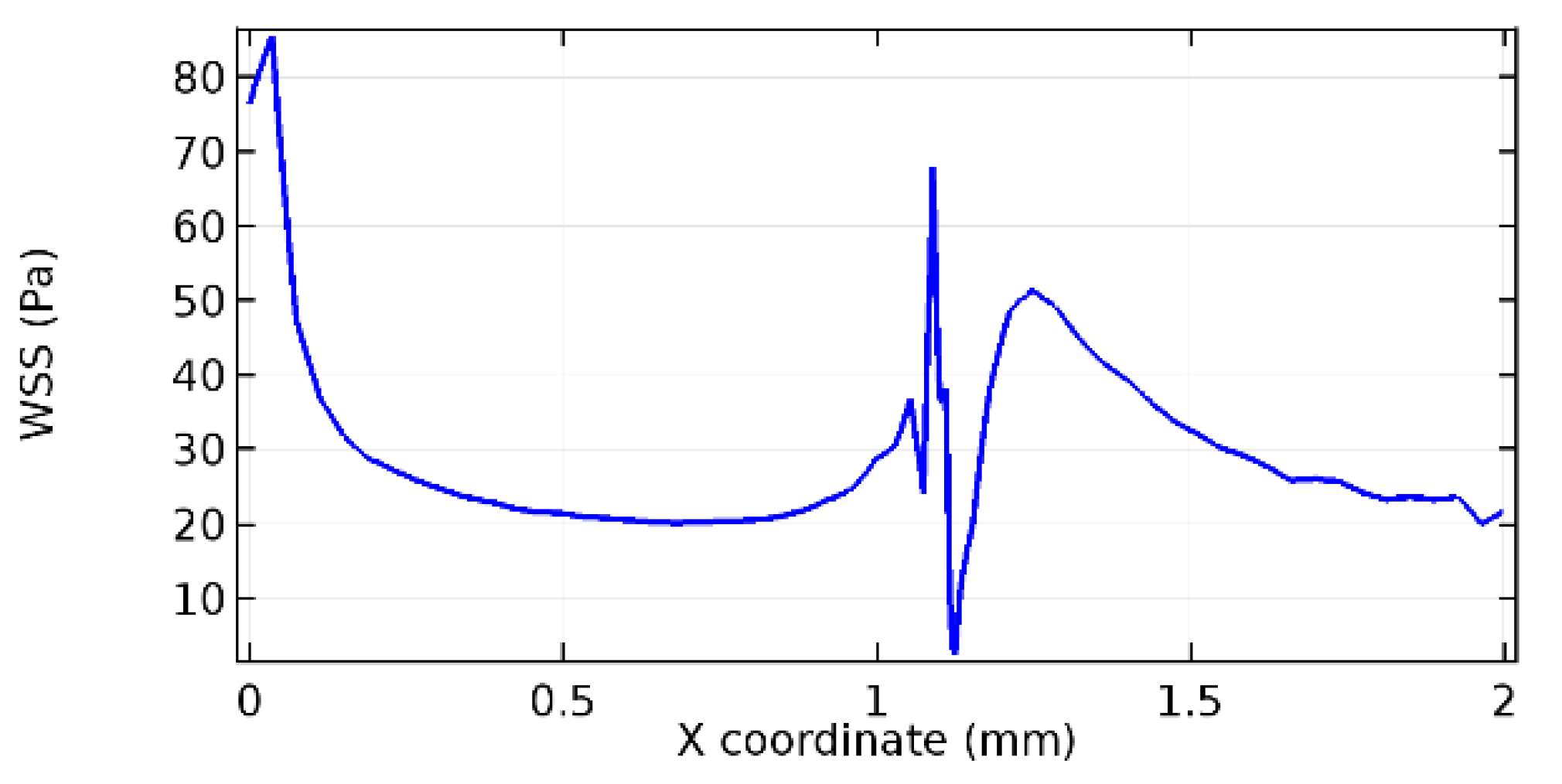

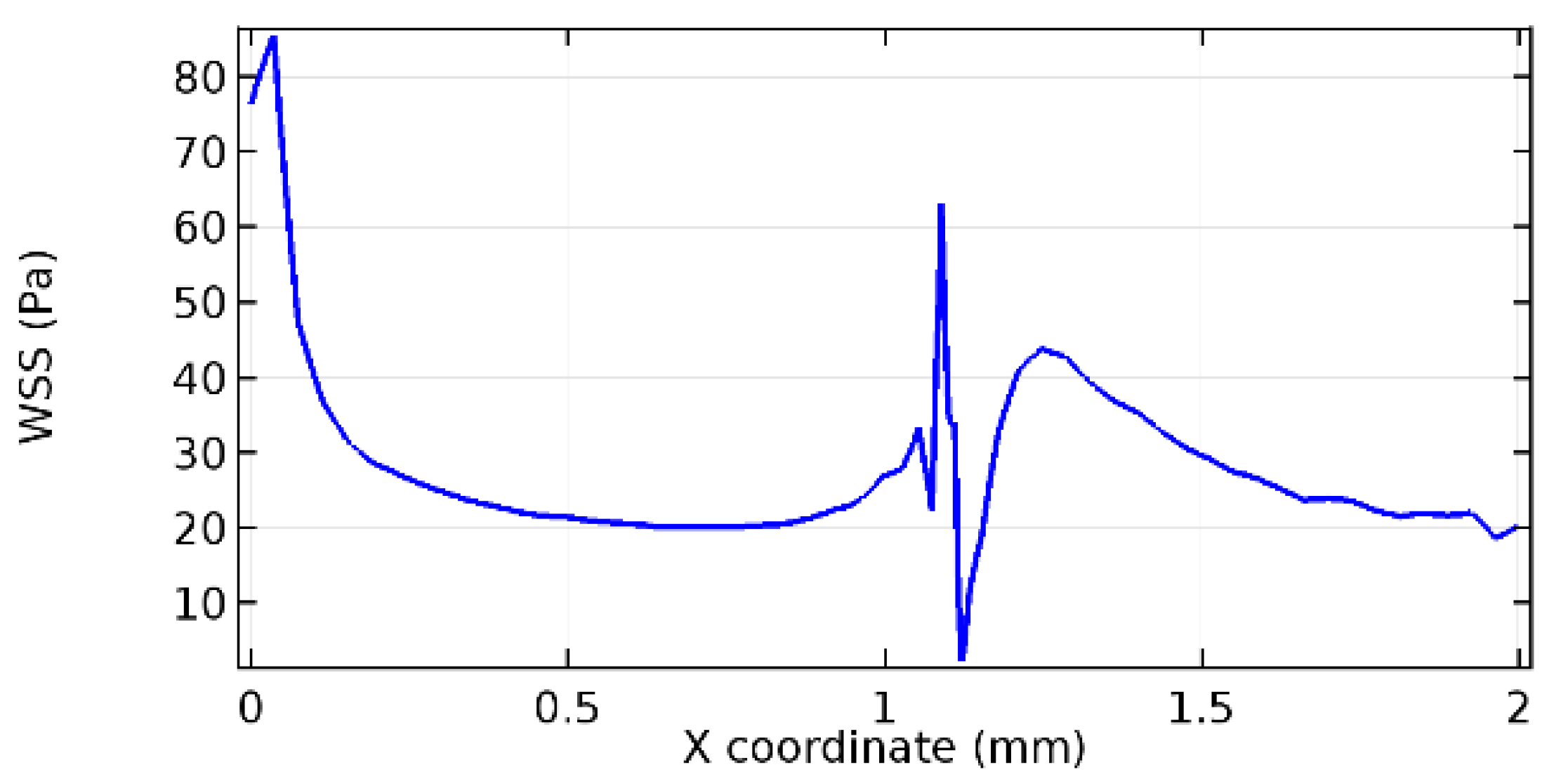
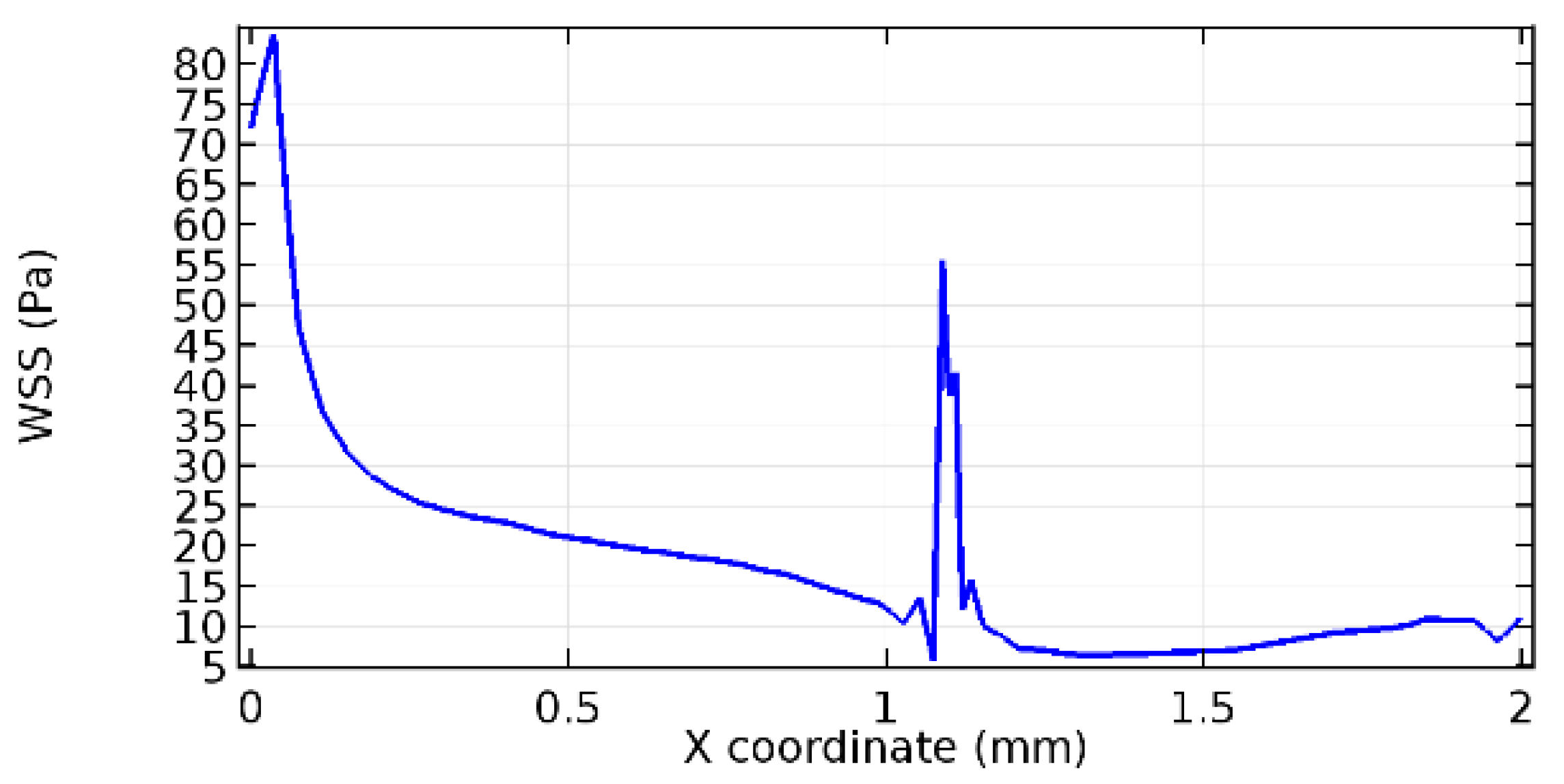
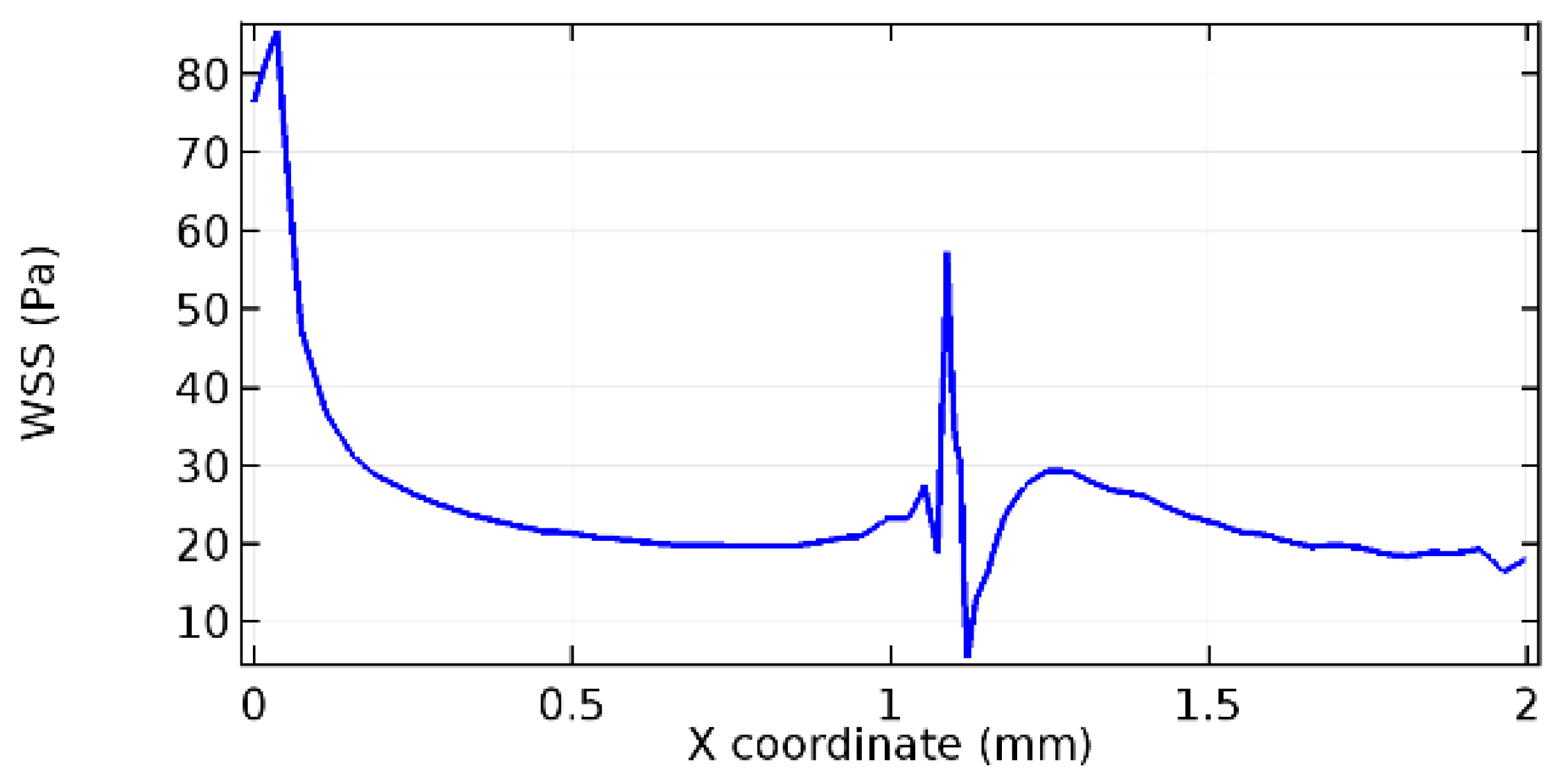
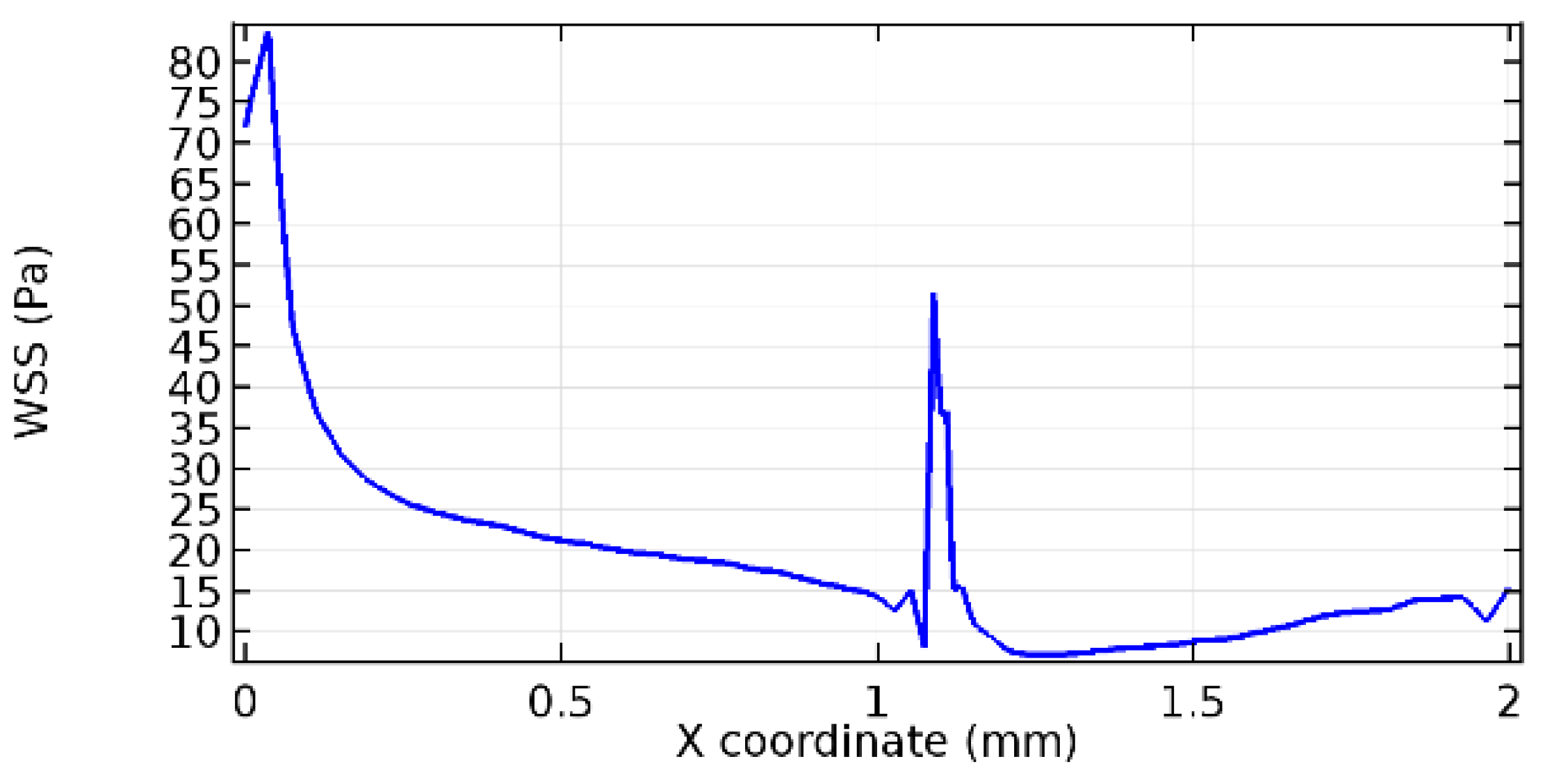
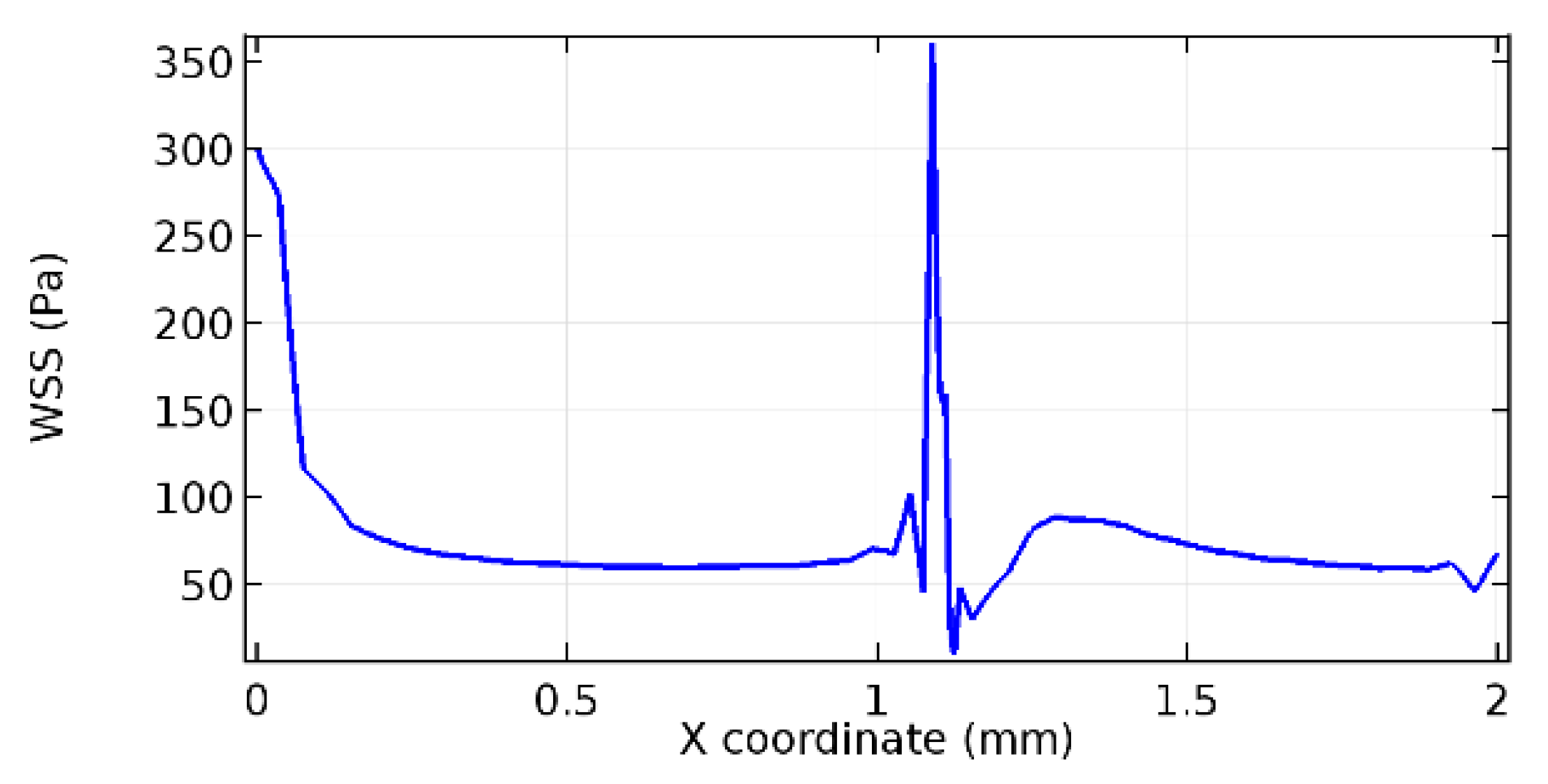
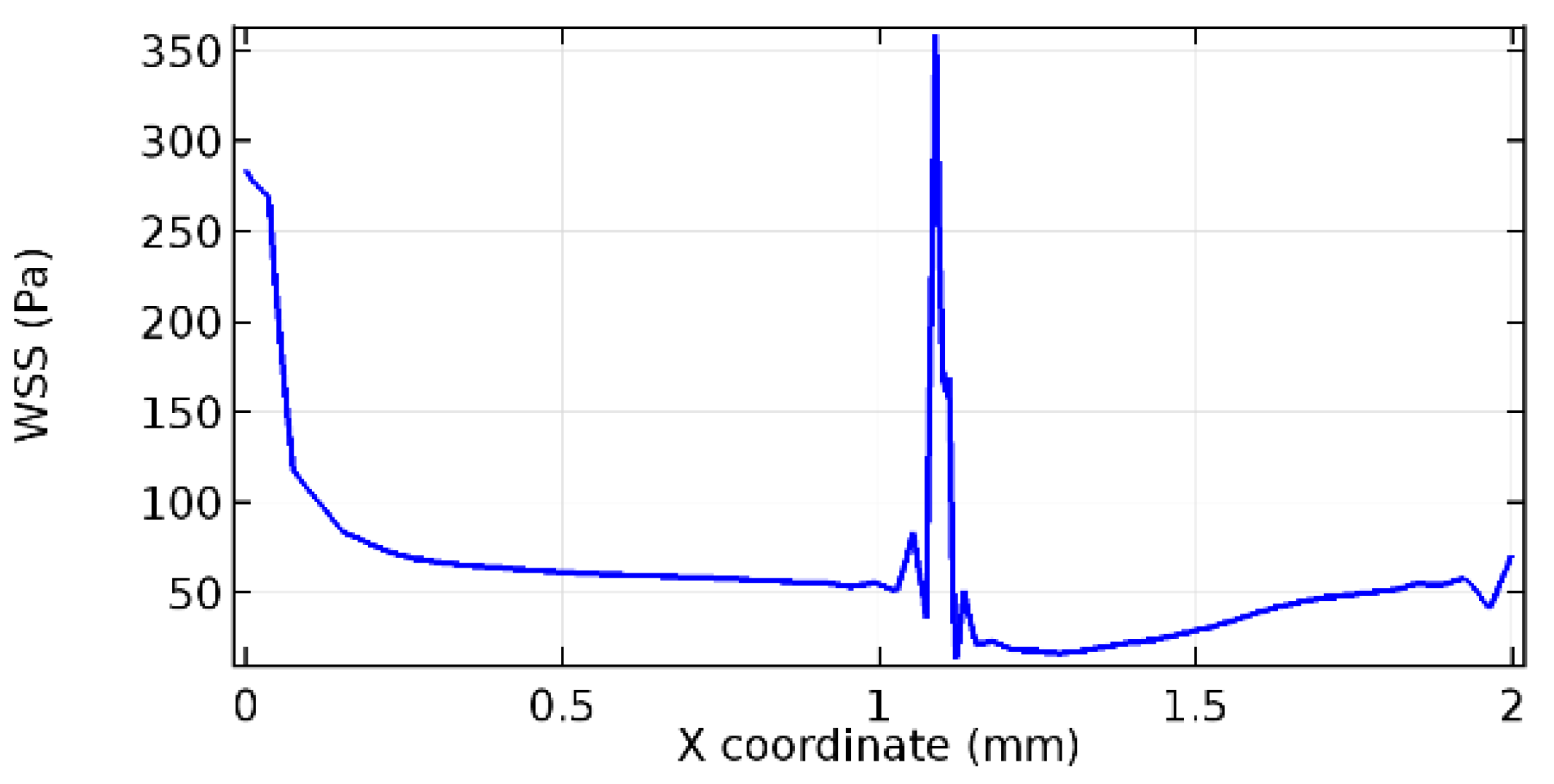
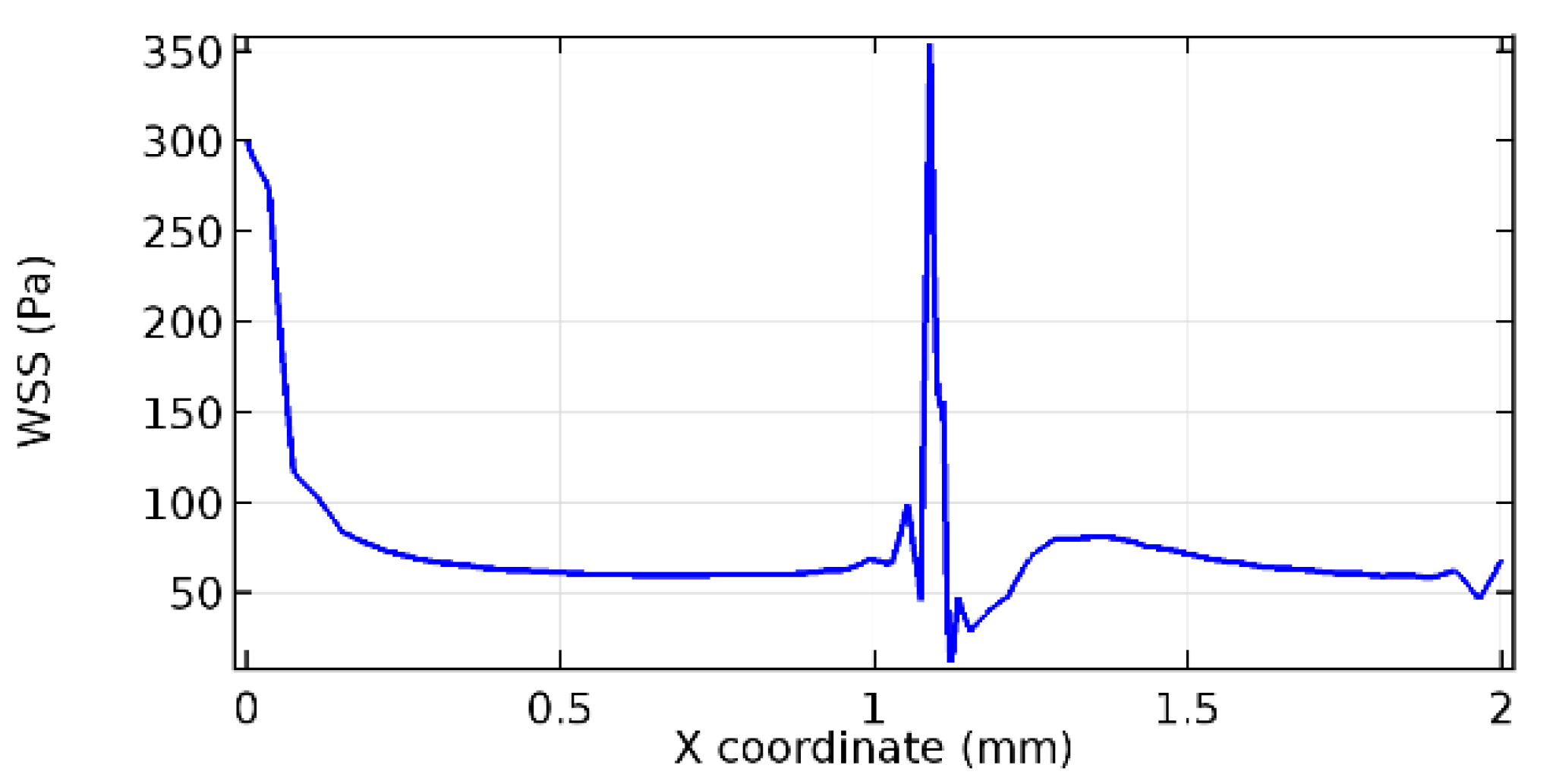

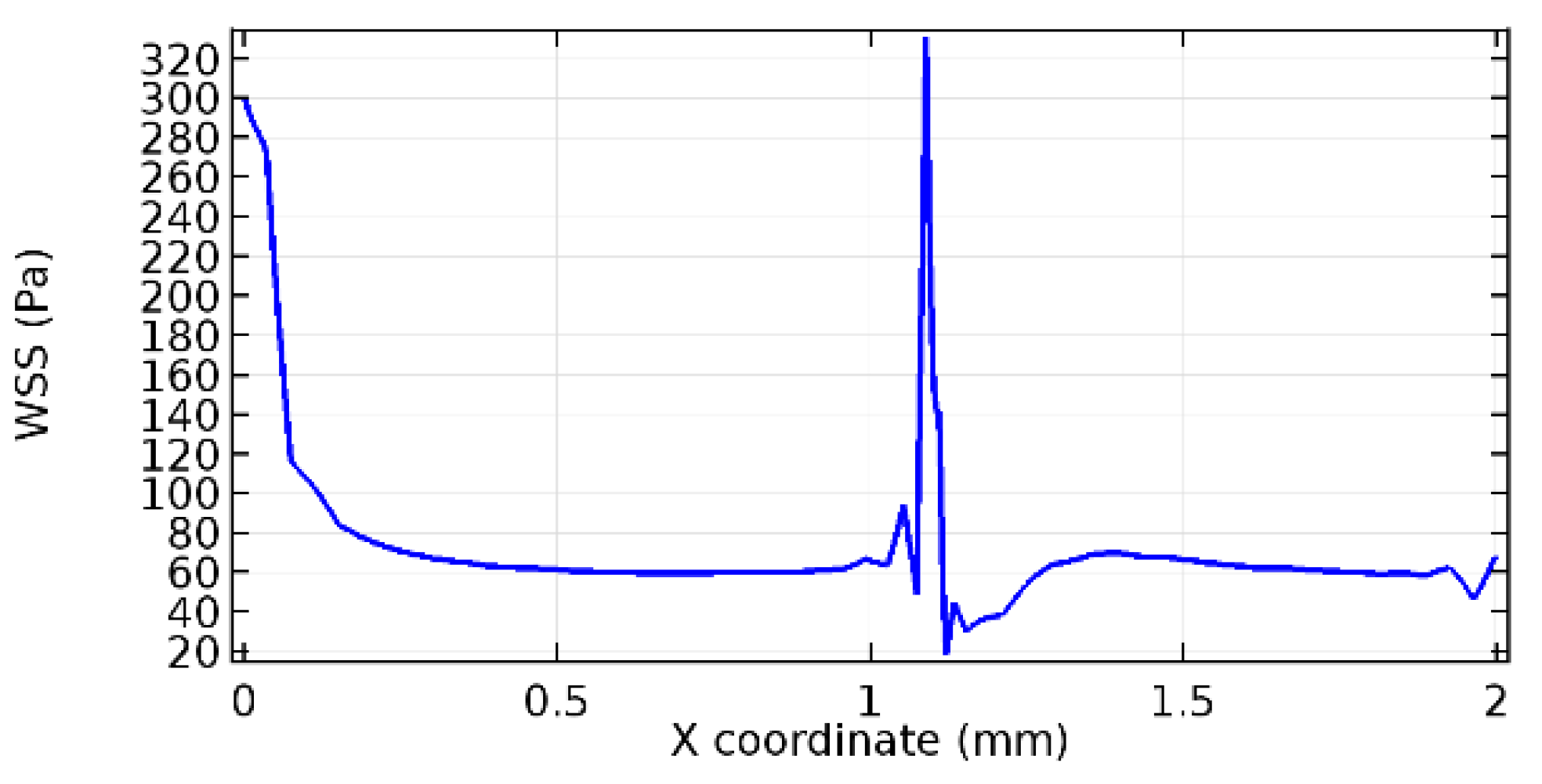


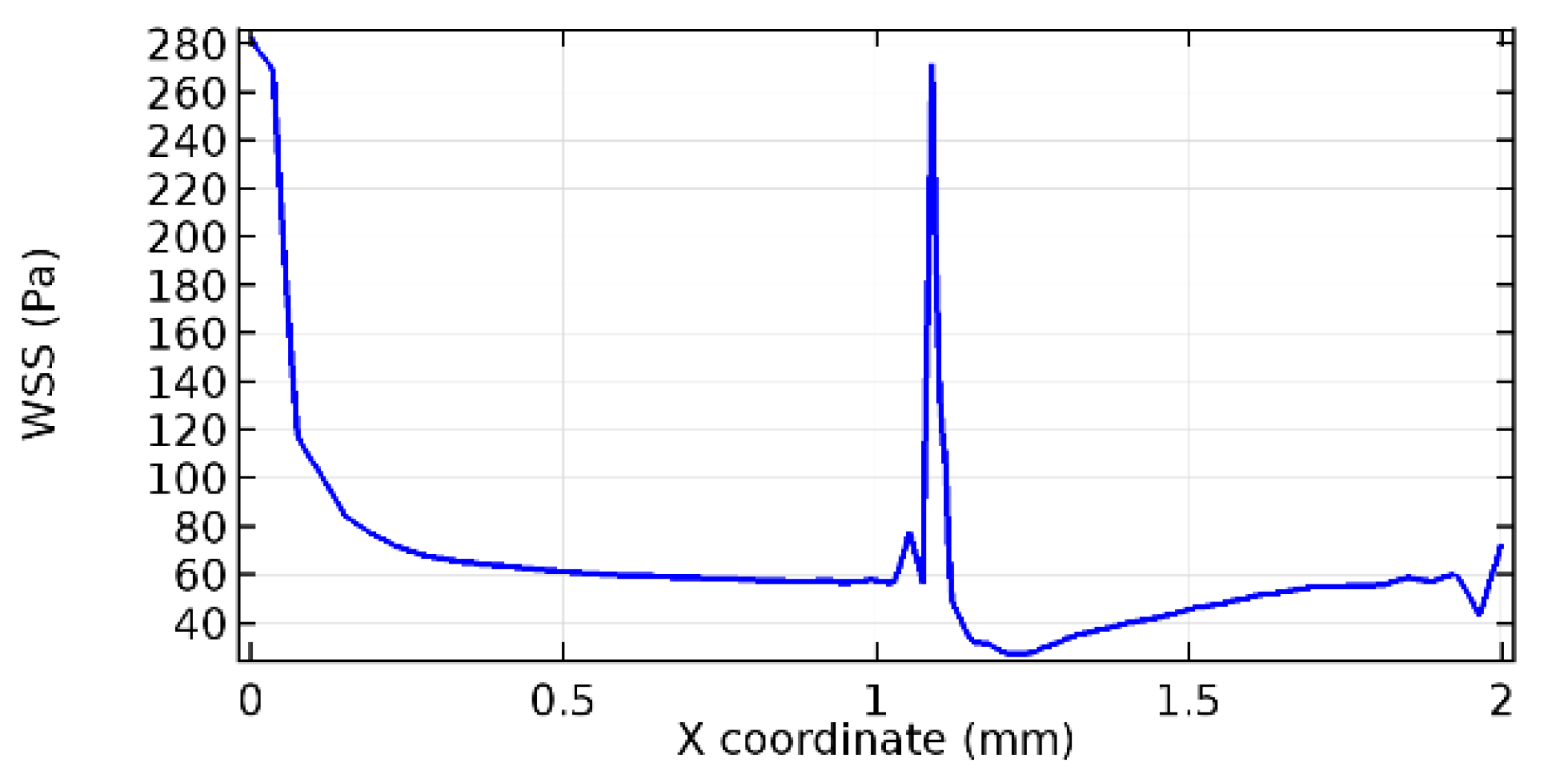
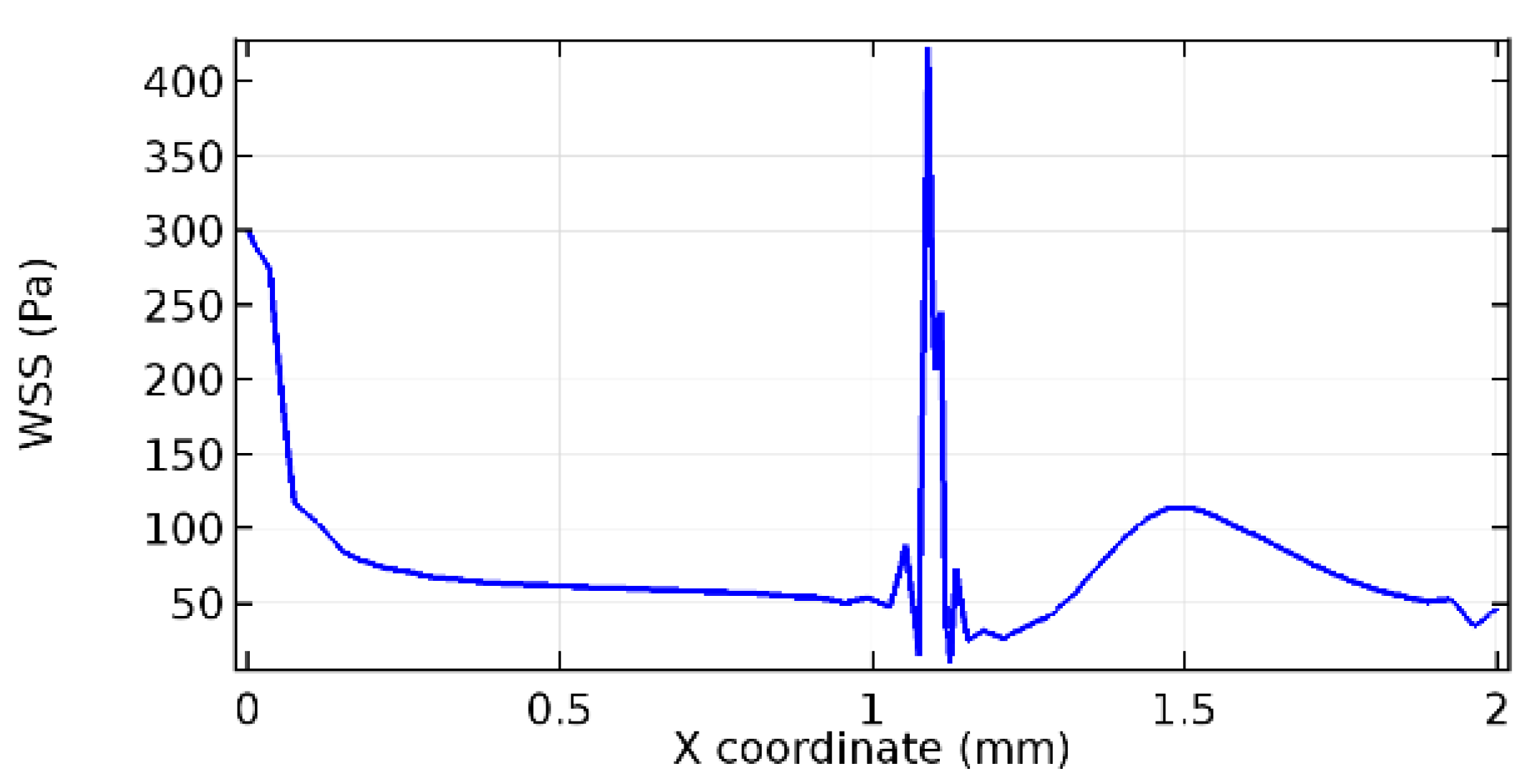
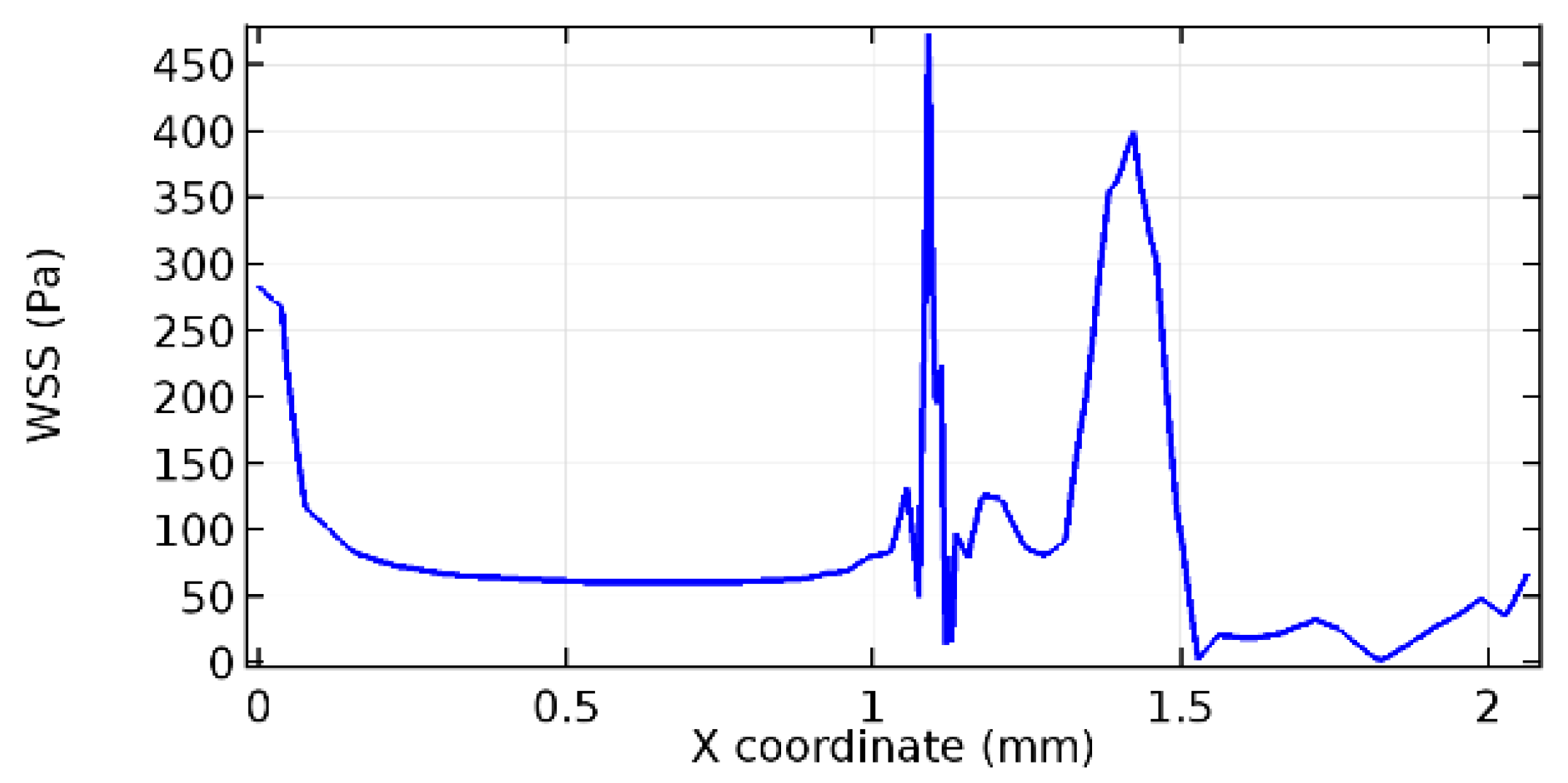
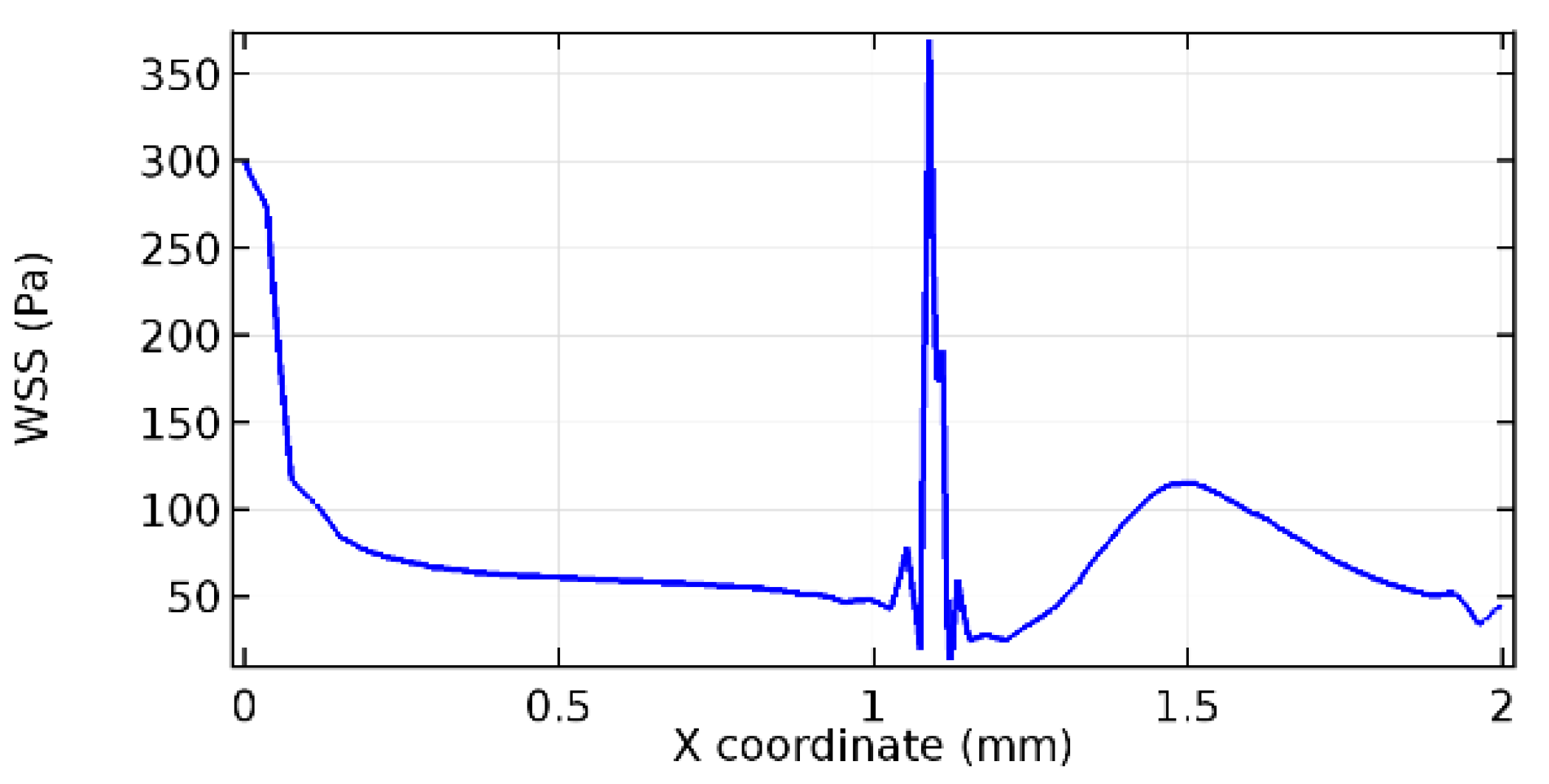
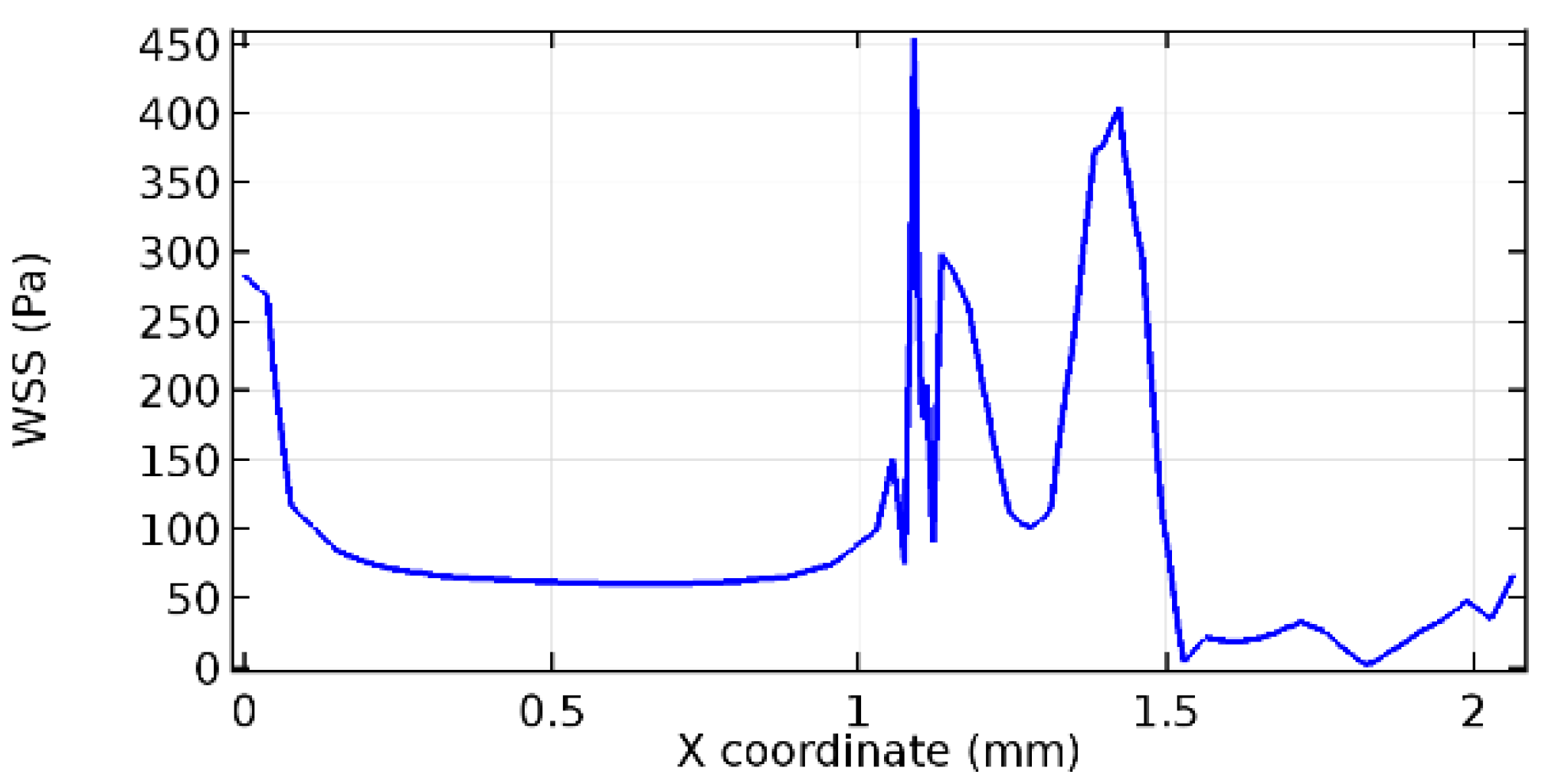
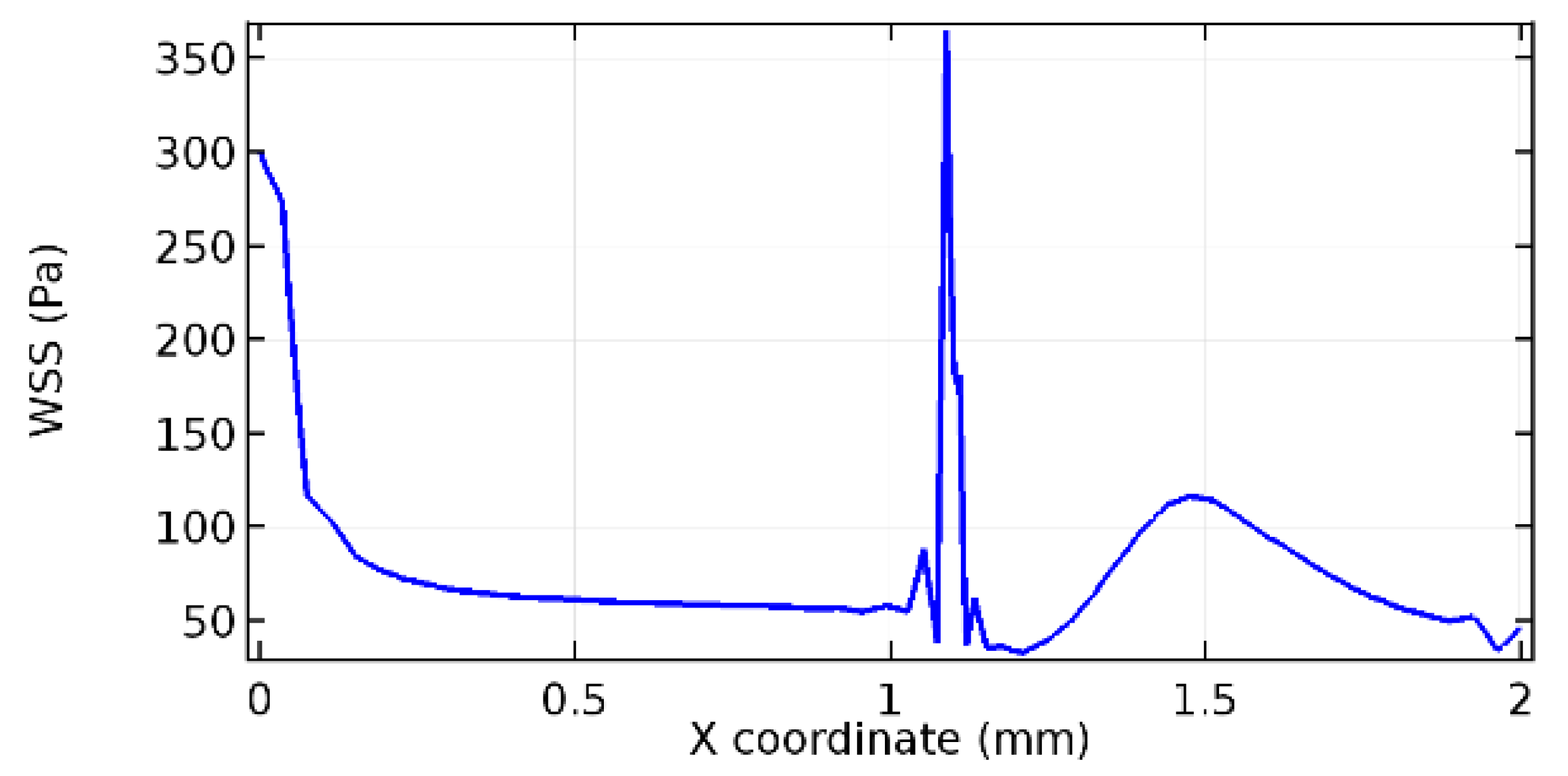




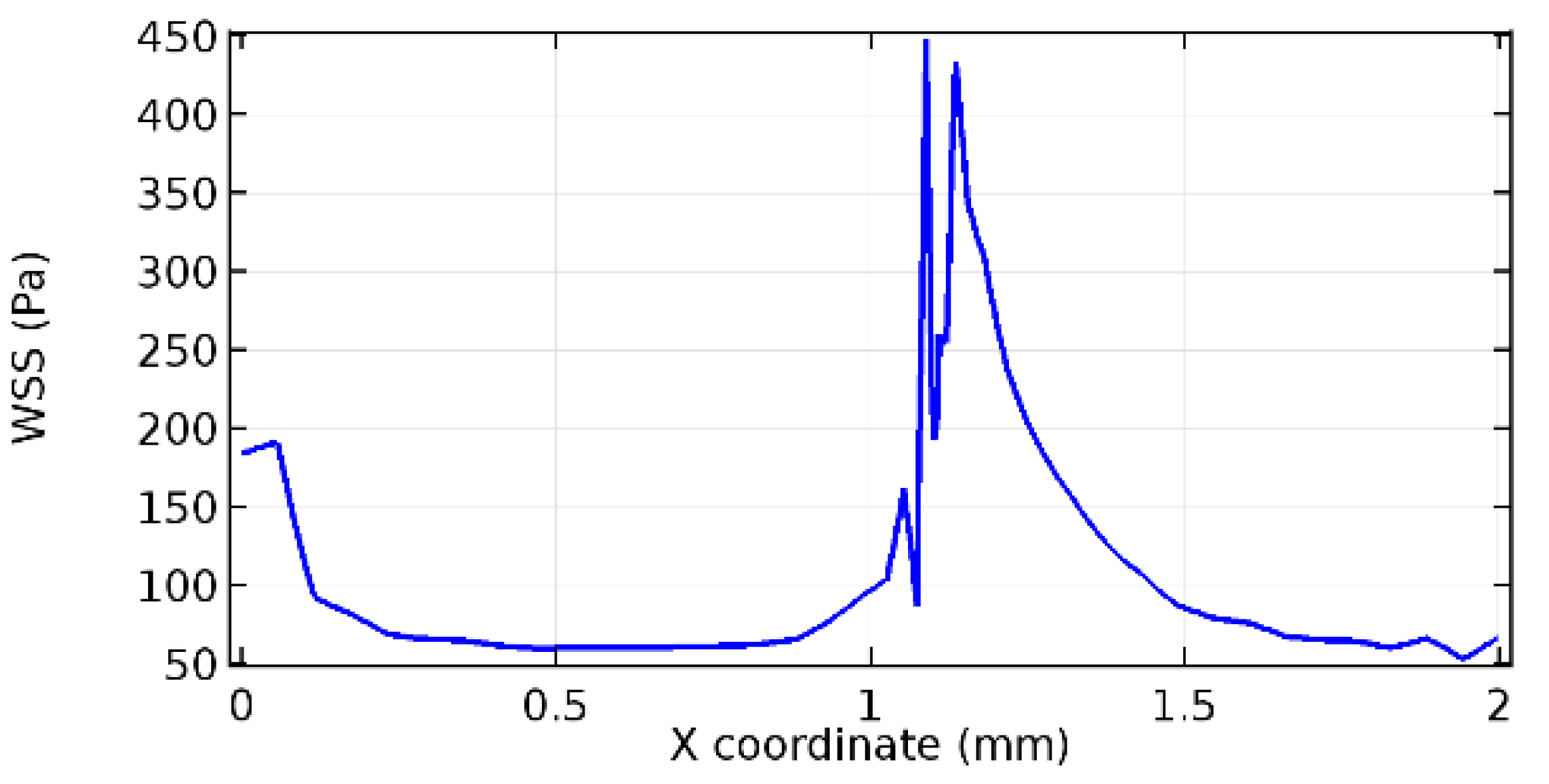

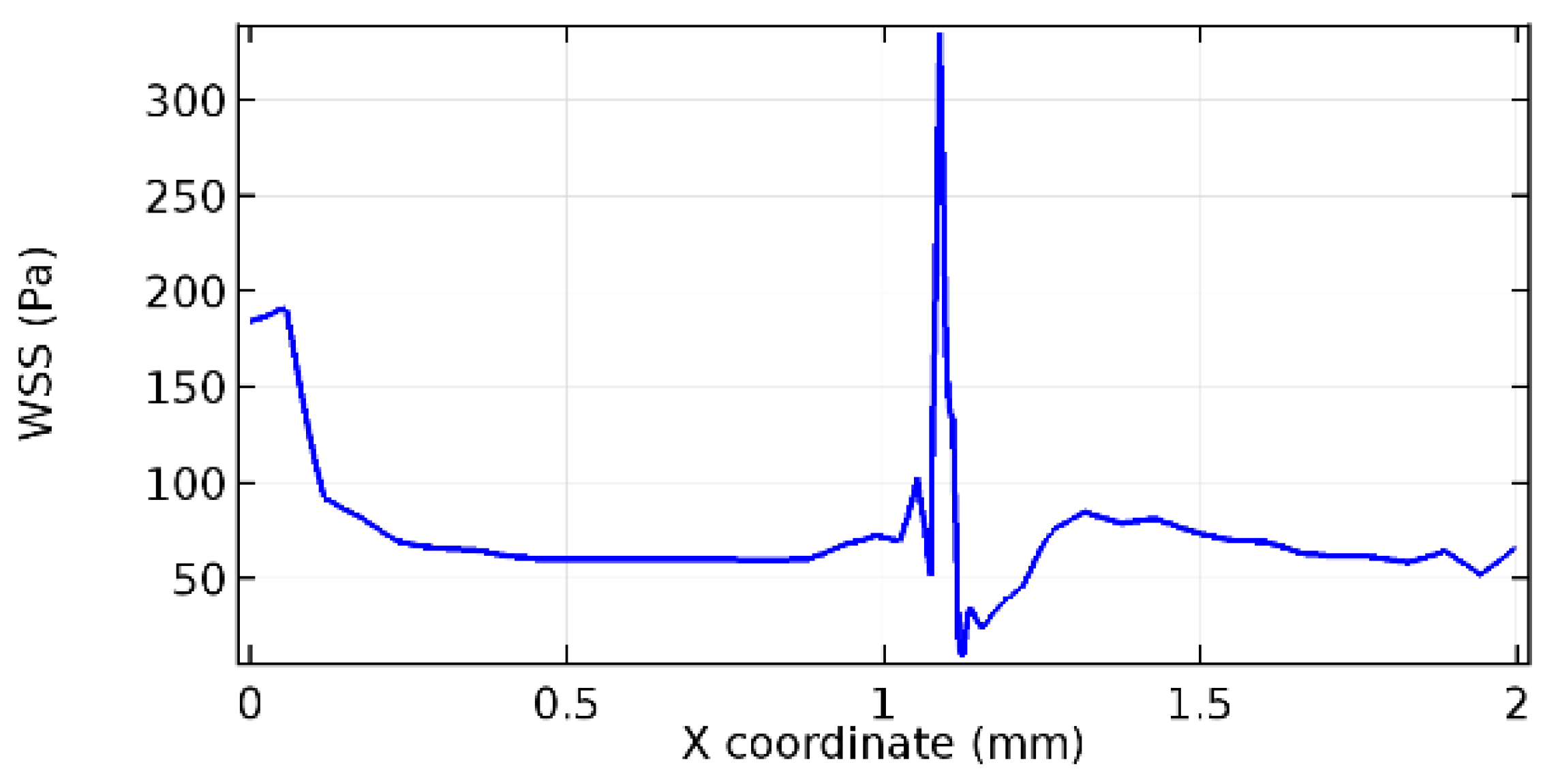
| Study Combinations | Healthy Inelastic | Stenosed Inelastic | Aneurysmic Inelastic | |
|---|---|---|---|---|
| Sl.No. | Mesh entities | |||
| 1 | Triangular elements | 12,636 | 12,230 | 6565 |
| 2 | Quadrilateral elements | 1428 | 1458 | 999 |
| 3 | Edge elements | 600 | 606 | 437 |
| 4 | Vertex elements | 8 | 13 | 8 |
| Domain element statistics | ||||
| 5 | Total number of elements | 14,064 | 13,688 | 7564 |
| 6 | Minimum element quality | 0.2539 | 0.2388 | 0.1078 |
| 7 | Average element quality | 0.8725 | 0.8683 | 0.832 |
| 8 | Element area ratio | 0.05841 | 0.0737 | 0.04112 |
| 9 | Mesh area | |||
| Parameters | Values | Source |
|---|---|---|
| Fluid properties: Blood | ||
| [39,40] | ||
| Fluid properties: Water | ||
| [44] | ||
| Solid properties: Graphene | ||
| Graphene density | [45] | |
| Permeability | ||
| Initial and Boundary Conditions | ||
| Initial pressure of the blood | [38,46] | |
| Inlet velocity of blood | ||
| Outlet pressure of blood | Null pressure | |
| Arteriole wall | No slip condition | |
| Condition Assumed | Fluid | Porosity of the Graphene Layer | DoF | Number of Iterations | Linear Error | Linear Residue |
|---|---|---|---|---|---|---|
| Healthy arteriole segment | Water | 2820 | 42 | |||
| 8.2% | 31 | |||||
| 10% | 24 | |||||
| Blood | 2820 | 34 | ||||
| 6% | 22 | |||||
| 7% | 21 | |||||
| 10% | 14 | |||||
| Stenosed arteriole segment | Blood | 2841 | 22 | |||
| 4.5% | 28 | |||||
| 6.5% | 33 | |||||
| Aneurysmic arteriole segment | Blood | 2841 | 85 | |||
| 4.5% | 129 | |||||
| 6.5% | 49 |
Disclaimer/Publisher’s Note: The statements, opinions and data contained in all publications are solely those of the individual author(s) and contributor(s) and not of MDPI and/or the editor(s). MDPI and/or the editor(s) disclaim responsibility for any injury to people or property resulting from any ideas, methods, instructions or products referred to in the content. |
© 2023 by the authors. Licensee MDPI, Basel, Switzerland. This article is an open access article distributed under the terms and conditions of the Creative Commons Attribution (CC BY) license (https://creativecommons.org/licenses/by/4.0/).
Share and Cite
Shankar Narayan, S.; Saeed, A.M.; Fatima, N.; Al-Duais, F.S.; Alharbi, K.A.M.; Puneeth, V.; Gorji, M.R.; Kheder, N.B.; Abdelmohsen, S.A.M. Possibilities for the Flow of Water and Blood through a Graphene Layer in a Geometry Analogous to Human Arterioles: An Observational Study. Appl. Sci. 2023, 13, 2000. https://doi.org/10.3390/app13032000
Shankar Narayan S, Saeed AM, Fatima N, Al-Duais FS, Alharbi KAM, Puneeth V, Gorji MR, Kheder NB, Abdelmohsen SAM. Possibilities for the Flow of Water and Blood through a Graphene Layer in a Geometry Analogous to Human Arterioles: An Observational Study. Applied Sciences. 2023; 13(3):2000. https://doi.org/10.3390/app13032000
Chicago/Turabian StyleShankar Narayan, S., Abdulkafi M. Saeed, Nahid Fatima, Fuad S. Al-Duais, Khalid Abdulkhaliq M. Alharbi, Venkatesh Puneeth, M. R. Gorji, Nidhal Ben Kheder, and Shaimaa A. M. Abdelmohsen. 2023. "Possibilities for the Flow of Water and Blood through a Graphene Layer in a Geometry Analogous to Human Arterioles: An Observational Study" Applied Sciences 13, no. 3: 2000. https://doi.org/10.3390/app13032000






